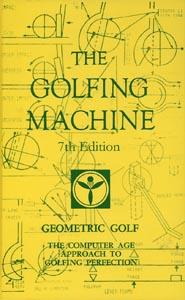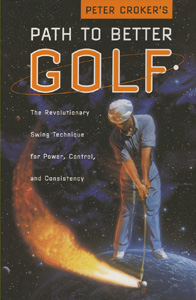Left Arm Swinging, Right Arm Swinging and Hitting
Click here to go to the index page.
Introduction:
This review paper compares the biomechanics/mechanics of left arm swinging versus right arm swinging versus hitting.
The basic chapters on the modern, total body golf swing, which represent the core golf instructional material on my website, is primarily devoted to the pivot-driven left arm swinger's action. I have never previously discussed right arm swinging in any of my review papers, and I am now correcting this problem-issue because I now believe that right arm swinging may be very suitable for a subset of golfers - elderly inflexible golfers or flexible golfers who swing better when using their dominant right hand as their major power source. I previously discussed hitting in my How to Power the Golf Swing review paper, and I will be comparing hitting to right arm swinging in this review paper - they are both right arm-powered swing styles, but there are significant differences in their fundamental biomechanics/mechanics.
This review paper is being written in September 2009 and it supplements the golf instructional information already available in my previously written review papers. I strongly advise website visitors to first read my How to Power the Golf Swing and my How to Move the Arms, Wrists and Hands in the Golf Swing review papers because I am going to presume that a reader understands all the TGM-concepts that I previously discussed in those review papers. A reader may become confused if he doesn't fully grasp all the TGM concepts, especially the power accumulator loading/release concepts, that I discussed in great detail in those review papers.
I am also repeating the pattern that I established in some of my previous review papers - by producing a multi-segment swing video lesson that goes over the same golf instructional material. The swing video lesson lasts approximately 1.75 hours and it is divided into 17 segments so that it can be hosted by U-tube, which limits any video segment length to <10 minutes. The swing video lesson can be viewed as a stand-alone swing video lesson, but a website visitor will obtain the maximum benefit if he views the swing video lesson and also reads this review paper, which contains much more detailed information. I divided the swing video lesson into 17 segments, and a viewer needs to view the 17 segments in sequence. I have listed the 17 segments here, but a viewer can simply start with segment 1 and then move on to segment 2 ----- etc. All the segments are listed under my U-tube nickname - Imperfect Golfer. In other words, a viewer can view all 17 segments in sequence without coming back to this webpage in order to click on further links.
Segment 1 - http://www.youtube.com/watch?v=Gl-Uf4hQPUQ
Segment 2 - http://www.youtube.com/watch?v=t2CEiOKsQc0
Segment 3 - http://www.youtube.com/watch?v=DB1hZjrD_W8
Segment 4 - http://www.youtube.com/watch?v=mvvvdp61798
Segment 5 - http://www.youtube.com/watch?v=J7ZyyuyF24A
Segment 6 - http://www.youtube.com/watch?v=GvKGxr8wc64
Segment 7 - http://www.youtube.com/watch?v=FLt6d7ard_0
Segment 8 - http://www.youtube.com/watch?v=yXcZxmfKJEo
Segment 9 - http://www.youtube.com/watch?v=q1_3bbIrE6A
Segment 10 - http://www.youtube.com/watch?v=Cb9ZRDnZi60
Segment 11 - http://www.youtube.com/watch?v=jwr7mSXQ3zw
Segment 12 - http://www.youtube.com/watch?v=NLC8dkfVtFg
Segment 13 - http://www.youtube.com/watch?v=koGNVkBDo4k
Segment 14 - http://www.youtube.com/watch?v=xCZ1avJJjY8
Segment 15 - http://www.youtube.com/watch?v=6E_qI3K92K0
Segment 16 - http://www.youtube.com/watch?v=9yb7AcdoLz0
Segment 17 - http://www.youtube.com/watch?v=zBScphW3kXw
A viewer should note that I am 61 years old and not very flexible. I therefore cannot perform all the required body/limb movements correctly in my swing video lesson. A viewer should therefore pay strict attention to what I am describing, and emulate my verbal descriptions, and not my visually-apparent motions. I made a few verbal slip-of-the-tongue errors during the video lesson, which was produced in a single unedited session, and I occasionally stated "left" when I meant "right" etc. The total number of slip-of-the-tongue- errors was small, so I am not formally listing all of the minor statement-errors in this review paper. Here is a list of some of the more major slip-of-the-tongue errors.
Segment 2 at 4:50 minutes - I stated 30 degrees turn, when I meant to state 30 degrees spinal tilt.
Segment 5 at 7:40 minutes - I stated bending of the left elbow, when I meant to state bending of the right elbow.
Segment 8 at 7:24 minutes - I stated 90 degree rotation when I meant to state 90 degrees right elbow bending.
Segment 11 at 0:45 minutes - I stated that Ernie Els swings very fast when I meant to state that he swings very slow.
I am going to devote most of this review paper to left arm swinging because it is the swing style used by the majority of professional golfers and advanced amateur golfers. It is the swing style that I specifically recommend as being particularly suitable for young, flexible golfers who do not have any physical limitations. I think that all golfers should first try left arm swinging when they first learn to play golf, and I think that they should only try to use a hitting or right arm swinging style if they can play golf better when using those alternative swing styles.
Left arm swinging
Introduction
Left arm swinging is the swing style used by the majority of professional golfers. They use their pivot-drive action to power the golf swing - by using a pivot-drive action to blast/catapult the left arm down-and-forwards towards impact (and this action represents the release of PA#4). The characteristic feature of a swinger's action is the fact that a golfer releases the club passively via a centrifugal action (release of PA#2). A left arm swinger shouldn't actively uncock the left wrist during the downswing and he also shouldn't use the right arm/hand to power the golf swing at any time-point during the downswing.
I have described the pivot-driven left arm swinging action in great detail in my downswing chapter and my How to Power the Golf Swing and How to Move the Arms. Wrists and Hands in the Golf Swing review papers. I am going to describe left arm swinging in a different way in this review paper and I am only going to emphasize certain points, which I suspect that many golfers do not fully understand. I frequently read the threads in many online golf discussion forums, and I have noticed that many golfers are very confused about certain aspects of left arm swinging (eg. concept of a "flat left wrist", concept of the "release" phenomenon, difference between the one-piece takeaway and the right forearm takeaway, how to move the pelvis at the start of the downswing, role of the right arm/forearm in the downswing), which I will discuss in great detail in this review paper.
Arm, wrist and and hand movements
The purest example of a left arm swinging action can be seen in this swing video of a left arm-only golf swing action - http://www.youtube.com/watch?v=uUTk7m5PozQIn this swing video, the golfer only uses his left arm to power the golf swing. It should be obvious to a viewer that the left arm-only golfer powers the golf swing by first loading his left arm against his upper chest wall during the backswing, when he turns his back towards the target. He then pivot-rotates his torso very fast towards the target as he starts the downswing and this pivot action blasts/catapults his left arm downwards-and-forwards through the impact zone. It is obviously true that some of his swing power must be derived from an active muscular contraction of his left shoulder girdle muscles, that pulls the left arm away from the chest wall. However, I believe that most of his swing power is derived from the active pivot action - as the upper torso rotates in the downswing, the left shoulder socket moves very fast towards the target and this left shoulder socket pivot motion pulls the left arm, which in turn pulls the club via its left hand grip attachment (at PP#2). A golfer needs to understand that the left arm mainly moves downwards-and-forwards in the direction of the ball and it doesn't move outwards (towards the ball-target line) very much. That fact allows the upper part of the left arm to remain in contact with the left pectoral area of the chest wall throughout the downswing and followthrough - even though the left arm is catapulted down-and-forwards in the direction of the ball. The concept of releasing PA#4 doesn't imply that the left arm must lose its close connection with the left pectoral area of the chest wall, and good left arm swingers, who pivot very well in the downswing/followthrough, maintain a "close connection" between the pivoting torso and swinging left arm at all times during the downswing and followthrough.
Note how the left arm-only golfer's left arm rotates in the backswing. The left arm internally rotates in the left shoulder socket during the backswing and that natural biomechanical action allows his flat left wrist (which faces the target at address) to rotate clockwise during the backswing, so that his flat left wrist faces skywards by the end of his backswing. A small amount of left forearm pronatory movement is also required to allow his flat left wrist/hand to get to its desired end-backswing position - roughly opposite, and slightly behind, his right shoulder. During the downswing, this swiveling motion of the left arm/forearm is reversed in a natural/automatic/passive manner - the left upper arm externally rotates in the left shoulder socket while the left shoulder socket moves in space, and the left forearm supinates so that the back of the flat left wrist/hand faces the target at impact. These biomechanical motions of the left arm/forearm occur naturally - if a golfer allows them to occur in a natural manner. A golfer should never attempt to contrive to move the left arm in a biomechanically unnatural manner in the backswing/downswing.
What represents the natural biomechanical motion of the left arm in a swinger's action?
In my accompanying swing video lesson, I demonstrate how the left arm tends to naturally move when a golfer pivot-rotates the torso in space. When a golfer pivot-rotates the torso in the backswing with the intention of getting his left hand opposite his right shoulder by the end of his backswing, the left arm will naturally/automatically rotate clockwise in the left shoulder socket joint and the left forearm will naturally/automatically pronate so that the back of the flat left wrist/hand will face skywards by the end of the backswing. The amount of left forearm pronation required depends on a golfer's posture.
Compare the posture and left arm/forearm movement during the takeaway of two golfers.
Stewart Cink - http://www.youtube.com/watch?v=4tjrAnidTu4&eurl
Kevin Sutherland - http://www.youtube.com/watch?v=Rzqejo538gI
Here are capture images from those swing videos.
Stewart Cink and Kevin Sutherland - capture images from their swing videos
Image 1 shows Stewart Cink at address. Note that he has a lesser amount of bent-over spinal tilt at address than Kevin Sutherland (image 3).Note, by the end of the takeaway, that Stewart Cink's clubface is roughly parallel to the ball-target line - toe of the club is pointing straight up and the clubface is slightly open to the clubhead arc (image 2), while Kevin Sutherland's clubface is still pointing at the ball - it is approximately square to the clubhead arc (image 4) and the toe of the clubhead is angled downwards. The reason for the difference is the variable degree of left forearm rotation (left forearm pronation) that is occurring during the takeaway - there is much more left forearm rotation (pronation) happening in Stewart Cink's takeaway action than Kevin Sutherland's takeaway action. Why does it occur?
I believe that a golfer, who stands more erect (like Stewart Cink), has to incorporate more left forearm rotation (coupled to his left arm's internal rotation action at left shoulder socket level) to get his flat left wrist to an end-backswing position (opposite and slightly behind the right shoulder) where it is facing skywards. In other words, a golfer needs to incorporate a takeaway swivel action in the backswing that allows the back of the flat left wrist/hand to lie parallel to the inclined plane in the mid-late backswing.
Consider this swing video of Tiger Woods' and Adam Scott's swings - http://youtube.com/watch?v=ZecViQxUwss
Note how their left arm/forearm rotates in the backswing so that the back of their flat left wrist/hand lies parallel to the inclined plane during the mid-backswing.
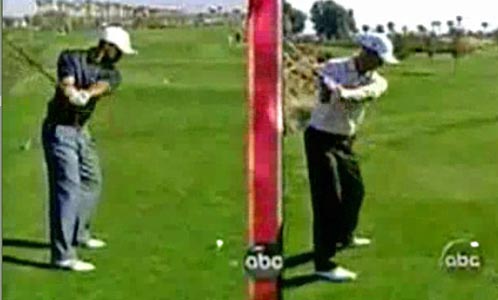
Tiger Woods and Adam Scott - mid-backswing position - capture images from their swing video
Note that Tiger Woods' and Adam Scott's clubshaft is on-plane in their mid-backswing - an imaginary straight line extension from the butt end of the club points at the ball-target line. Note that the back of their flat left wrist/hand lies against/parallel to the inclined plane (which is roughly intermediate between the elbow plane and the turned shoulder plane at this time-point in the backswing).During their downswing, this biomechanically natural left arm/forearm movement will be automatically reversed. The flat left wrist/hand will be brought down the inclined plane until the hands reach the delivery position (third parallel) and then the left hand will undergo a natural release swivel action in the late downswing (from the third parallel position to its impact location) so that the back of the flat left wrist/hand can face the target at impact.
Most professional golfers adopt an erect posture, like Tiger Woods/Adam Scott/Stewart Cink, and they therefore utilize a takeaway swivel action in the backswing and a release swivel action in the downswing.
It is possible for a left arm swinger to avoid having to use a takeaway swivel action in the backswing, and a release swivel action in the downswing, if he bends over more at hip level - like Kevin Sutherland. The golf instructor, Jim Hardy, teaches this particular swing methodology in his Hardy one-plane swing technique (Hardy OPS).
Jim Hardy recommends that his OPS golfers bend over more at hip level, so that they acquire approximately a 40 degree spinal tilt angle at address [1].
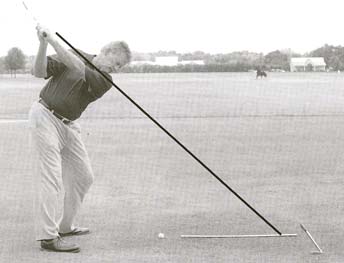
Jim Hardy demonstrating his backswing shoulder turn angle - from reference number [1]
Note that Jim Hardy has an approximately 40 degree spinal tilt angle, and note that he turns his shoulders at a relatively steep angle to the ground (compared to Tiger Woods and Adam Scott who have a more horizontal shoulder turn motion in the backswing) - note that the black line (representing his shoulder turn angle) hits the ground between 2-4' from the ball-target line. Jim Hardy wants his OPS golfers to have a centralised spine at address, and he recommends that his OPS golfers simply rotate their upper torso at right angles to their bent-over/centralised spine during the backswing.
Here is a photograph of Jim Hardy performing his "Brute Drill" - a pivot-action drill recommended by Jim Hardy [1].
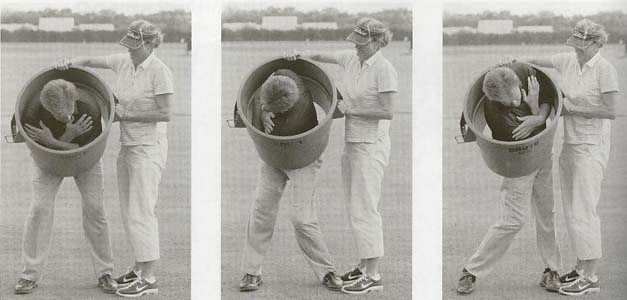
Jim Hardy demonstrating his Brute drill - from reference number [1]
The name "Brute" is derived from a large plastic garbage container that is called the "Brute". Jim Hardy cut off the top of the container, so that he can utilise it for his drill. Image 1 shows how Jim Hardy has an approximately 40 degrees forward spinal tilt at address and a centralised spine (no rightwards spinal tilt). Image 2 shows Jim Hardy rotating his upper/lower torso as an unit in the backswing - with the upper torso rotating perpendicularly around his centralised spinal axis. Image 3 shows Jim Hardy performing his recommended downswing pivot action - where he rotates his shoulders perpendicularly around his centralised spinal axis.
Jim Hardy also recommends that a Hardy OPS golfer avoid using a takeaway swivel action in the backswing and he recommends that a Hardy OPS golfer keep the clubface relatively square to the clubhead arc during the early backswing.
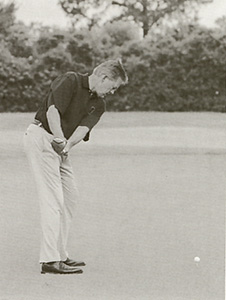
Jim Hardy demonstrating his recommended OPS takeaway - from reference number [1]
Note how Jim Hardy is keeping the clubface pointing at the ball during the takeaway - note that the toe of the club is tilted downwards. Note that Jim Hardy is not intentionally rotating the left arm/forearm so that the back of the flat left wrist/hand lies against/parallel to the inclined plane by the mid-backswing.It is possible to play excellent golf using the Hardy OPS style. However, very few professional golfers use the Hardy OPS, and I think that a major factor is the difficulty involved in performing a fluid pivot action when bent over at 40 degrees. It takes a great deal of athletic flexibility to pivot-rotate the upper/lower torso as a single unit around a centralised spine when bent-over at 40 degrees, and most professional golfers prefer to stand more erect and pivot-rotate around a rightwards tilted spine (as described in many of my review papers on the "standard" left arm swinger's pivot action). Golfers who choose to adopt the "standard" left arm swinging approach must therefore always incorporate a takeaway swivel action during the early backswing and a release swivel action in the mid-late downswing.
Movement of the flat left wrist/hand during a left arm swinger's action
I have stated that the flat left wrist/hand should face the target at address, and then face skywards by the end of the backswing. During the backswing action, the left wrist should remain flat. What is meant by the term "flat left wrist"?
It is important that a golfer understand the difference between an anatomically flat left wrist and a geometrically flat left wrist (neutral left wrist).
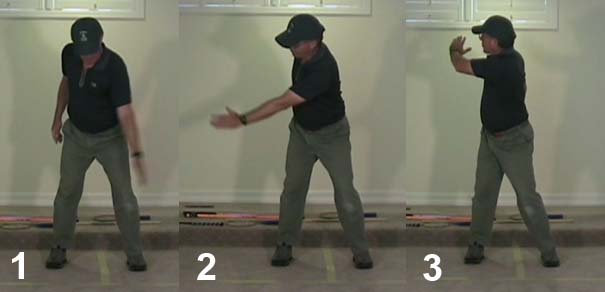
Author demonstrating the motion of the flat left wrist in the backswing
In the above series of three capture images from my swing video lesson, I am demonstrating how one can keep the left wrist flat throughout the backswing, while the left arm is internally rotating and the left forearm is pronating. Note that I have started with my fingers stretched-out, which straightens/flattens the left wrist, and note that the flat left wrist is perfectly straight-in-line with the back of the left forearm (image 1). In that image, the left wrist is anatomically flat. However, under normal circumstances, a golfer holds the club's grip in the lower palm of his left hand in a grip action that resembles the making of a fist. What happens to the left wrist when a golfer makes a fist?If one places one's left forearm on the surface of a table and relaxes all one's forearm muscles, then one will notice that the fingers automatically become flexed (5th finger more flexed than the 4th finger, and 4th finger more flexed than the 3rd finger, and 3rd finger more flexed than the 2nd finger) and the left wrist automatically becomes dorsiflexed (cupped/scooped). This hand position is called the "anatomical position of rest of the hand" and the wrist/hand/finger positional alignments reflect the resting muscle tone in the forearm muscles. In other words, the back of the left wrist becomes cupped/scooped due to the natural amount of dorsiflexion that occurs when the hand is in its "anatomical position of rest". However, a cupped/scooped left wrist doesn't mean that the left wrist is bent. If one loosely places the grip end of a golf club in the left hand while the left forearm rests on the table, while making sure that the clubshaft is perfectly straight-in-line with the left forearm, the left wrist will still appear cupped/scooped - even though the left wrist is not bent. The amount of cupping/scooping naturally increases if one adopts a slightly stronger left hand grip (2-3 knuckle grip) rather than a weak left hand grip (one knuckle grip), and the amount of cupping/scooping naturally increases when one grips a wider rounded object.
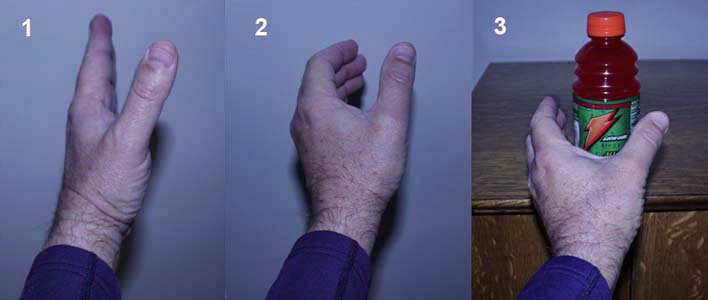
Author demonstrating the phenomenon of natural left wrist cupping/scooping
Image 1 shows an anatomically flat left wrist that accompanies the active stretching-out of the fingers, which automatically straightens/flattens the left wrist. Image 2 shows the natural left wrist cupping/scooping that occurs when the hand is in its "anatomical position of rest". Image 3 shows that the degree of cupping/scooping of the left wrist increases when grasping a wide rounded object that is straight-in-line with the left arm.
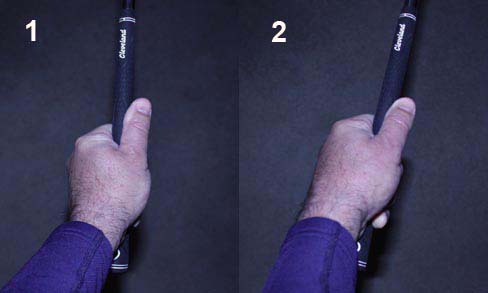
Author demonstrating a "flat left wrist"
Image 1 shows that the left wrist becomes slightly cupped/scooped when the left hand grasps a rounded grip - even if the left wrist is not bent (clubshaft is held straight-in-line with the left forearm). In this situation, the left wrist is geometrically flat (neutral left wrist). To get the left wrist to appear to be anatomically flat, one has to palmar flex the left wrist slightly - image 2 - and in that situation the clubshaft is not in a straight-in-line relationship with the left forearm. This anatomically flat left wrist position is the desired position of the left wrist/hand at impact - when the hands are closer to the target than the clubhead (clubshaft has forward shaft lean). In other words, if a golfer has an anatomically flat left wrist at any time-point in his backswing/downswing, then it signifies that he has palmar flexed his left wrist slightly.Re-examine this swing video comparing Tiger Woods' and Adam Scott's swings - http://youtube.com/watch?v=ZecViQxUwss
Note that both Tiger Woods and Adam Scott maintain an anatomically flat left wrist (slightly palmar flexed left wrist) throughout their backswing/downswing.
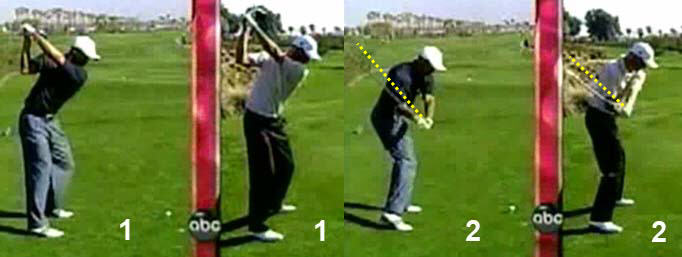
Tiger Woods and Adam Scott - capture images from their swing video
Image 1 shows that both Tiger Woods and Adam Scott have an anatomically flat left wrist at the end-backswing position. Because their left shoulder socket and left hand are roughly on the same plane, they can have the left arm and clubshaft in a perfectly straight-line left arm flying wedge relationship.Image 2 shows that both Tiger Woods and Adam Scott maintain an anatomically flat left wrist during the mid-downswing - even though their left hand is much lower than the left shoulder socket. Note that both golfers had to slightly palmar-flex their left wrist to maintain an anatomically flat left wrist - and that causes the clubshaft to be shallowed-out slightly (the dotted yellow line represents the position where their clubshaft should be if it was in a perfectly straight-in-line left arm flying wedge relationship with the left arm).
Having an anatomically flat left wrist is not obligatory, and it is perfectly acceptable for a golfer to have a geometrically flat left wrist (neutral left wrist that appears slightly scooped/cupped) during the backswing/downswing. What is not acceptable is having a bent left wrist - a cupped/scooped left wrist that is due to the clubshaft not being in a relatively straight-in-line relationship with the straight left arm (and where the left arm flying wedge straight-in-line alignment between the straight left arm and clubshaft is significantly altered).
I previously stated that the left wrist should remain flat (either anatomically flat or geometrically flat) during the backswing while the left wrist upcocks. During the backswing, the left wrist must upcock so that a golfer can establish a 90 degree relationhsip between the straight left arm and the clubshaft by the end of the backswing. Does the right wrist also have to upcock during the backswing - when the left wrist is upcocking?
Many golfers incorrectly believe that the right wrist also has to upcock during the backswing - if the left wrist upcocks. Also, many golf instructors teach this principle.
In his recent golf instructional book [2], Hank Haney states on page 68-: " Imagine you are standing at address. Now pick the clubhead straight up in front of your nose by hinging your wrists (figure 49). That is exactly the wrist motion you want to make in your backswing. Of course, it never looks like that in the golf swing because that motion is combined with your shoulder turn, your arm swing, and the rotation of your forearms".
Here is figure 49 from his book [2].
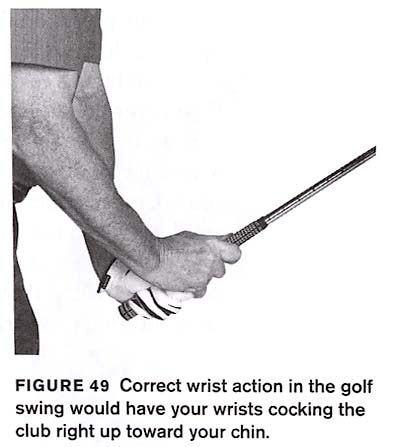
Note that Hank Haney is recommending that a golfer should upcock both the right wrist and the left wrist in the backswing. I think that Hank Haney is wrong, and I think that it is preferable to not upcock the right wrist during the backswing.Consider the implications of cocking both wrists upwards in the backswing by viewing this swing video of Ryan Moore's swing - http://www.youtube.com/watch?v=_m3lCmj9yrU
Note that Ryan Moore cocks both wrists upwards in the backswing and that action causes his clubshaft to move off-plane and steepen considerably during the mid-late backswing.
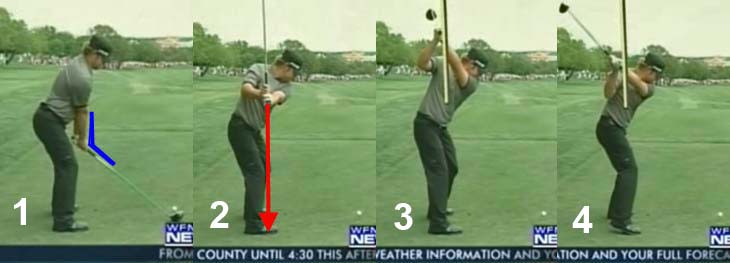
Ryan Moore's backswing action - capture images from his swing video
Image 1 shows that Ryan Moore has a relatively large power accumulator #3 angle - angle between his left arm and clubshaft (angle between the blue lines) - at address.Image 2 shows that Ryan Moore cocks both wrists upwards during his mid-backswing and that causes his clubshaft to move off-plane (red arrowed line = an imaginary extension line extending from the butt end of the club, that points at his feet, instead of pointing at the ball-target line).
Image 3 shows Ryan Moore's end-backswing position - note that his left arm is angled steeply above his right clavicle and his hands are well above the right shoulder.
Image 4 shows Ryan Moore in his early downswing. Note how he drops his hands to a position behind his right shoulder and note how this action shallows his clubshaft and gets his left arm to lie along the shoulder turn angle. He is now in a perfect postion to start the downswing with an on-plane downswing action.
The disadvantage of Ryan Moore's backswing action is that he has to employ a compensatory move to get to the desired end-backswing position (image 4). I think that it is advantageous to learn how to perform a backswing action that gets the hands to their desired end-backswing position (image 4) while simultaneously keeping the clubshaft on-plane throughout the backswing - by using a right forearm takeaway. I described the right forearm takeaway in great detail in my How to Move the Arms, Wrists and Hands in the Golf Swing review paper. One of the key features of a right forearm takeaway backswing action is the "biomechanical requirement" to bend (dorsiflex) the right wrist backwards while keeping the right wrist level (not allowing the right wrist to cock upwards).
The fundamental biomechanical principle that a golfer needs to understand is the biomechanical principle that allows a golfer to cock the left wrist upwards in the backswing without having to simultaneously cock the right wrist upwards.
The biomechanical phenomenon that allows the left wrist to cock upwards (without the right wrist cocking upwards) is the biomechanical fact that the right elbow bends (folds) to a 90 degree angle in the backswing. It is the bending/folding of the right elbow that allows/causes the left wrist to cock upwards, and during this biomechanical action the right wrist only bends backwards (dorsiflexes) without necessarily cocking upwards. In other words, the bending of the right elbow allows the directional motion of the right wrist to be perpendicular to the directional motion of the left wrist - the right wrist moves in a horizontal plane (hinging plane of dorsiflexion) while the left wrist moves in a vertical plane (cocking plane of radial deviation). The fact that the right wrist moves in a plane of motion that is perpendicular to the plane of motion of the left wrist is a critically important fact, and this biomechanical phenomenon allows a golfer to get the right forearm flying wedge to be roughly perpendicular to the left arm flying wedge by the end of the backswing (analogous to the supporting wing strut of a small Cessna airplane supporting the airplane wing).
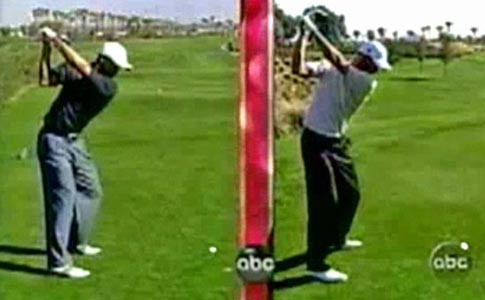
Tiger Woods and Adam Scott's end-backswing position - capture images from their swing video
Note how the clubshaft is at a 90 degree angle to the left arm at the end-backswing position with the clubshaft being straight-in-line with the left arm - this represents the left arm flying wedge. Note that the right forearm flying wedge is angled at roughly a 90 degree angle to the left arm flying wedge, and this is only biomechanically possible because the right wrist is bent backwards while the right elbow is bent/folded to roughly a 90 degree angle.Note that both Tiger Woods and Adam Scott have their left arm roughly across their shoulder turn angle - similar to Ryan Moore in image 4.
Ben Hogan recommended this backswing action in his book [3] and he used the following diagram to make his point.
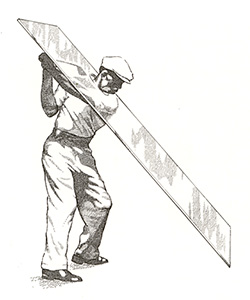
Ben Hogan's glass plane image - from reference number [3]
Ben Hogan advised golfers in his book to have a shallow left arm backswing action that ensured that the left arm never broke through the imaginary pane of glass during the backswing. I think that most modern professional golfers - like Tiger Woods - are following Ben Hogan's advice, and a key learning principle is learning how to assemble the power package (loaded left arm flying wedge and loaded right forearm flying wedge) below that imaginary glass plane. To achieve that goal, it is important not to allow the right wrist to cock upwards during the mid-backswing (while the right elbow is folding).Look at this swing vide of Ben Hogan's swing and note how his right wrist bend backwards (dorsiflexes) without cocking upwards during his backswing.
http://www.youtube.com/watch?v=QL_6M_xZvq0
Here is a link to another superb golfer, John Erickson, who has a similar swing - where the left arm doesn't crash through the imaginary pane of glass.
http://www.youtube.com/watch?v=Bh5wZ0J8rXU
Note that John Erickson's right wrist bends backwards (dorsiflexes) without cocking upwards. Both golfers (Ben Hogan and John Erickson) use the right forearm takeaway, rather than the one-piece takeaway, during their backswing - note how close their right elbow remains in relationship to their right torso in the backswing and note how soon the right elbow starts bending/folding in the backswing.
By contrast, Tiger Woods and many professional golfers, use an one-piece takeaway. Both the one-piece takeaway (which I described in my backswing chapter) and the right forearm takeaway (which I described in my How to Move the Arms, Wrists and Hands in the Golf Swing review paper) are perfectly acceptable backswing takeaway actions and they both assemble the power package assembly (left arm flying wedge and right forearm flying wedge) correctly at the end-backswing position. I prefer the right forearm takeaway because I think that it allows the arms to remain more "connected" to the body during the backswing, and there is less risk of having the arms move in a disconnected manner relative to the rotating torso. I also think that it is easier to keep the clubshaft on-plane using the right forearm takeaway, and it is also easier for the arms/hands to follow the same arm/hand arc path in the downswing. Golfers, who use the one-piece takeaway, have a very wide arm/clubshaft arc in the backswing, and a much narrower arm/clubshaft path in the downswing.
Body pivot action movements
The body's pivot action is critical to a left arm swinger's action because it supplies the necessary swing power to release PA#4 (release the left arm).I have described the pivot action in great detail in a number of my review papers and I will discuss certain important points in this review paper.
I increasingly believe that a fluid and complete pivot action is essential for a left arm swinger's action, and I increasingly believe that golfers should consider adopting an alternative swing style if they do not have the flexibility to complete the pivot action with great fluidity.
What represents a complete pivot action?
I demonstrate the pivot action in my swing video lesson. The following series of capture images demonstrates certain important points regarding the pivot action.

Author demonstrating the pivot action drill - capture images from his swing video lesson
To perform this pivot action drill, a golfer needs to place a dowel stick, or golf club, behind his back - as demonstrated in image 1. Then, he should complete a backswing pivot action that will allow him to get the dowel stick to be perpendicular to the ball-target line - image 2. It will require approximately a 45 degree pelvic rotation and a 90 degree upper torso rotation to get to this position. Then, a golfer should perform a downswing pivot action that continues to the finish position - image 3. At the finish position, the golfer should be standing erect with the pelvis square to the target and the right shoulder should be closer to the target than the left shoulder. During the downswing pivot action, the right shoulder must move downplane and move under the chin while the golfer retains his spine angle (avoids standing up).The first requirement when assessing whether a golfer can perform the pivot action satisfactorily, is to assess whether a golfer has enough flexibility to complete the pivot action (from address => backswing => downswing => finish). However, that is not sufficient, because the pivot action must also be executed with great fluidity of motion. If you look at my swing video lesson, you will note that I have insufficient flexibility to perform the complete pivot action fluidly. I have therfore failed the test, and I cannot expect to perform a left arm swinger's action well - because a fluidly-performed pivot action is an essential requirement. Golfers who lack the flexibility to perform the complete pivot action with great fluidity should consider alternative swing styles, which may result in better, and more consistent, ball contact.
Although I have described the pivot action in great detail in a number of my review papers, I am going to emphasize certain important points that I didn't fully discuss in those review papers.
Pivot posture at address
A golfer needs to have a suitable posture at address that will not only allow him to pivot his torso while remaining in balance throughout the entire pivot action - he must also have sufficient room under his chin for the swinging arms to swing freely in front of his rotating torso during the late downswing and followthrough.
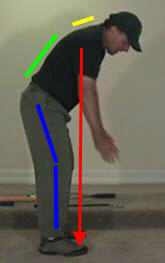
Author demonstrating address posture - capture image from his swing video lesson
This capture image demonstrates a number of important postural features that a golfer needs to get right.1) There must be a small degree of knee flex (blue lines).
2) A golfer must bend at the level of the hips, and not at the waist, which will result in a rounded back. To achieve that goal, a golfer must stick his butt-out so that his lower back can remain straight (green line) when he bends at the level of the hips. The "correct" amount of forward spinal bend is approximately 30 degrees - and a rough rule is that a straight line drawn down the back of the right arm vertically-down to the ground should pass just in front of the knee caps and hit the forefoot, or toes (red arrowed line). If the posture is correct, then the golfer's weight should be equally distributed between the balls of the feet and the heels. A golfer should "feel" like a football quarter-back who is ready to receive a ball that is going to be thrown from a huddle setup.
3) The upper back should be rounded (yellow line) so that the golfer can look straight down at the ball, without having to flex the neck.
4) The upper arms should hang vertically down from the shoulder sockets, and the hands should be under the chin (for a driver) and closer to the thighs (for a short iron).
Consider another aspect of body posture that is best viewed from a face-on view - spinal/upper torso tilt.
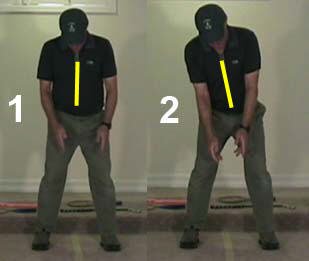
Author demonstrating rightwards spinal tilt at address
Why does a golfer need rightwards spinal tilt at address? A golfer needs to have rightwards spinal tilt at address for two major reasons - i) the right hand is lower on the grip than the left hand by "X" inches and the right shoulder must be lower than the left shoulder at address by roughly the same "X" amount of inches; and ii) a a golfer needs to pivot around a rightwards tilted spine to acquire the "correct" reverse-K postural alignment at the end-backswing position - without indulging in any lateral swaying of the upper torso.I have recently changed my recommendations for achieving the "correct" amount of rightwards spinal tilt at address (image 2).
Consider image 1 - note that I am standing in a tripod-fashion with my weight equally distributed between the left foot and right foot, with a straight spine (yellow line) and my head centralised between my feet. There are two ways to acquire rightwards spinal tilt from that centralised tripod posture.
1) A golfer could keep the pelvis centralised between the feet and simply tilt the upper torso to the right (away from the target). That will produce rightwards spinal tilt and it will cause the head to move slightly rightwards (so that is behind the center of the stance).
2) A golfer could shift the pelvis slightly to the left while keeping the head relatively centralised. If the pelvis moves slightly leftwards, it will cause the lower lumbar spine to move leftwards. If the head is kept relatively stationary in the center of the stance, then a golfer will have acquired rightwards spinal tilt - image 2.
I now favor the second approach of acquiring a small degree of rightwards spinal tilt at address. The major reason for favoring this approach is that it "feels" like the left leg is already braced at address - if the pelvis is shifted to the left at address. I think that swinging against a braced left side in the downswing, without having a problem of excessive left-lateral pelvic slide during the downswing, is very useful and I think that adopting a braced left pelvis/leg at address is useful from this perspective. I also think that it is better for a golfer to keep the head relatively centralised between the feet at address, and I believe that a golfer should also attempt to keep the head relatively stationary in that same relatively-centralised position throughout the backswing and downswing. If a golfer adopts approach number 1, and acquires rightwards spinal tilt by tilting the upper torso away from the target while keeping the pelvis centralised, it causes the head to move back too far back behind the center of the stance. This head-position may predispose to "hanging back" on the downswing.
Each individual golfer can experiment with these two optional approaches in order to discover which approach works better for him.
Backswing pivot action
I have described the backswing pivot action in great detail in my The Backswing and Downswing Hip Pivot Movements: Their Critical Role in the Golf Swing review paper and my Optimal Weight Shift in the Full Golf Swing review paper. I am therefore only going to emphasize certain points in this review paper.
I think that a golfer should pivot-rotate his torso around his rightwards-tilted spine in the backswing and avoid any lateral swaying of the pelvis and/or upper torso to the right. To achieve that goal, a golfer needs to maintain the flex in his right knee, and ensure that the right knee does not move right-laterally to any degree during the backswing pivot action. It is acceptable for the right knee to straighten slightly - as viewed from a back-to-front perspective.
A key movement of the pelvis in the backswing pivot action is a "feeling" of withdrawing the right hip. The word "withdrawing" merely signifies that the right buttock is pulled back away from the ball-target line, so that the pelvis acquires approximately a 45 degree rotation by the end of the backswing. During this pelvic rotational movement, the right buttock moves leftwards as well as backwards.
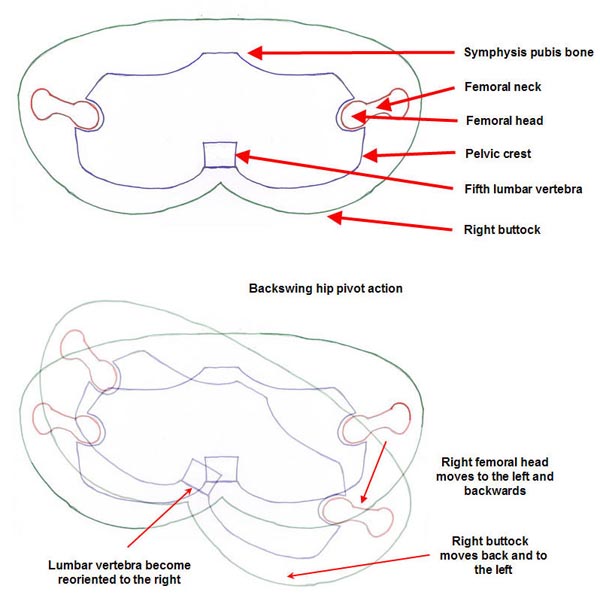
Cross-sectional diagram of the body at the level of the hip joints
Note the effect of the pelvic rotational movement on the orientation of the lumbar vertebra - note that the lumbar vertebra become rightwards-oriented when the right buttocks moves back-and-leftwards. That means that the lumbar spine, and also the lower thoracic spine, becomes rightwards-oriented during the backswing pivot action, and this creates the reverse-K look of a golfer at the end-backswing position.
A golfer can learn the "feeling" of acquiring a reverse-K posture by the end of the backswing by performing the crossing-guard drill.
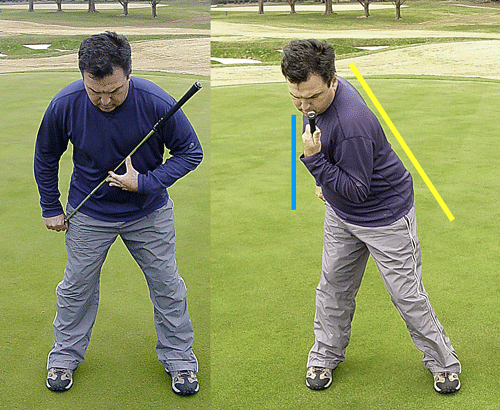
Brian Manzella demonstrating the crossing-guard drill - from reference number [4]
In this drill, one places a golf club across the front of the torso - from the left shoulder to the right hip. Then, one performs a standard backswing pivot action by withdrawing the right buttock. Note how this action causes the upper torso to acquire a rightwards-slope (yellow line) and note how the clubshaft becomes perpendicular to the ball-target line (blue line). Brian Manzella is "exaggerating" this movement and a golfer should not allow the head to move so much to the right when acquiring a reverse-K posture by the end of the backswing.
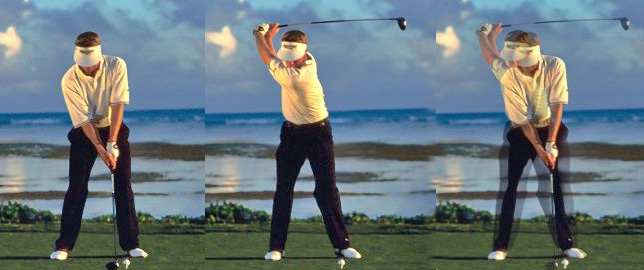
Stuart Appleby's head movement during the backswing - images adopted from a swing video
Note that Stuart Appleby has acquired a reverse-K posture by the end of his backswing (image 2) . However, note that he didn't move his head very much during the backswing - see composite image 3.Note that Stuart Appleby's left leg is straighter than his right leg at address - that is due to the fact that he has shifted his pelvis slightly to the left at address in order to acquire a small amount of rightwards spinal tilt. Note that Stuart Appleby didn't allow his lower or upper torso to sway to the right during the backswing, and he simply performed a rightwards-centralised backswing pivot action around his rightwards-tilted spine. He is therefore in a perfect position at the end of his backswing to start the downswing pivot action with a hip-shift rotation movement.
Downswing pivot action
The downswing pivot action starts from the ground-up and the pelvis must preferably move first, and the upper torso must preferably move secondarily.
Many golfers have difficulty initiating the downswing pivot action with a hip shift-rotation movement, and I will discuss a number of optional techniques that a golfer can use to start the downswing with a lower body movement.
A common reason why certain high handicap amateur golfers have difficulty starting the downswing with a pelvic shift-rotation movement is due to the fact that they didn't rotate the pelvis in the backswing. If a golfer has a static pelvis in the backswing (keeping the pelvis square to the ball-target line) and if he only rotates the upper torso in the backswing, then it becomes very difficult to initiate the downswing with a pelvic shift-rotation movement. If the pelvis is square to the ball-target line at the end-backswing position, then the only lower body movement that a golfer can easily perform to start the downswing is a left-lateral sliding of the pelvis towards the target. That causes the pelvis to "lock-up" in a position that is too far left-lateral of the left foot and the golfer cannot easily rotate the left buttocks rearwards towards the tush line (left hip clearing action).
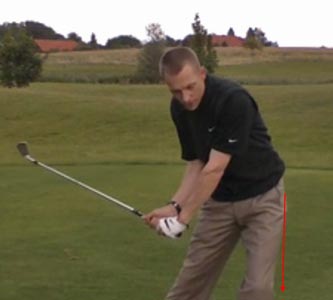
Oliver Heuler demonstrating a pelvic over-slide movement - from reference number [5]
Note that Oliver Heuler has slid his pelvis too far left-laterally towards the target, and the excessive sliding movement of his pelvis "locks-up" his pelvis and prevents him from being able to execute a left hip clearing action (rotation of the left pelvis back towards the tush line). This problem predisposes a golfer to pushed/push-sliced shots because the golfer cannot continue to pivot-rotate the upper torso around to the left post-impact.It is therefore very important that a golfer rotate the pelvis to a certain degree in the backswing - preferably by approximately 45 degrees.
A golfer's technique of starting the downswing pelvic movement is also significantly affected by a golfer's degree of hula hula flexibility. The term "hula hula flexibility" refers to a golfer's ability to rotate the lumbar spine and pelvis without simultaneously rotating the upper thoracic spine and upper torso. Belly dancers have a large amount of hula hula flexibility and that biomechanical fact allows them to gyrate their pelvis while keeping their upper torso and head stationary.
In my swing video lesson, I demonstrated a simple test that a golfer can perform to roughly assess his level of hula hula flexibility. Basically, if a golfer can rotate his pelvis >20 degrees at the start of the downswing, while keeping the shoulders back, then he has a large amount of hula hula flexibility. If he can rotate it 10-20 degrees, while keeping the shoulders back, then he has a moderate amount of hula hula flexibility. If a golfer can only rotate the pelvis <10 degrees, while keeping the shoulders back, then he has a small amount of hula hula flexibility. If a golfer cannot keep the shoulders back, and the shoulders turn instantaneously when the pelvis starts to rotate, then the golfer (like the author) has zero hula hula flexibility.
If a golfer has a moderate-large amount of hula hula flexibility, then he may prefer to start the downswing pelvis shift-rotation movement during the late backswing - while the club is still moving to its final end-backswing position.
Consider how Tiger Woods starts the downswing in this manner.
http://www.aroundhawaii.com/assets/articles/2008/10/1500/images/2008-10_tiabeyond001.gif
In that animated gif, you can see that Tiger Woods starts moving his pelvis - even while the arms/club is moving back to its end-backswing position. Starting the downswing in this manner has the advantage of a smooth transition between the backswing and downswing. However, it is only possible to start the downswing in this manner if a golfer has a lot of hula hula flexibility. The pelvic movement consists of two components - a "falling" onto the left foot (which is significantly unweighted by the end of the backswing) and a pulling back of the left pelvis towards the tush line (left hip clearing action).
You can see Tiger Woods' pelvic motion in great detail in this swing video - http://www.youtube.com/watch?v=4wxn0sIkJH8
Note how Tiger Woods starts his backswing by rotating his pelvis against a braced right leg, which prevents any swaying of his pelvis right-laterally away from the target. Note how the left pelvis moves away from the tush line in the backswing. During this process, note how the left knee moves rightwards and slightly outwards (towards the ball-target line) and this is due to the fact that the left leg is becoming progressively more unweighted during the late backswing - even if the left heel remains in contact with the ground. Note how Tiger Woods reverses this "pelvic movement" process in the early downswing - note how the left knee moves back to the left and note how his left pelvis gets pulled back towards the tush line. Note that there is no deliberate sliding of the pelvis left-laterally towards the target. Once the left pelvis gets pulled back towards the tush line, the left hip clearing action continues uninterruptedly in a continuous motion. There is a moment-in-time when Tiger Woods' pelvis is square to the ball-target line, but that moment-in-time is really only perceptible when viewing a swing video in slow motion. In reality, Tiger Woods' downswing pelvic motion is really a continuous pulling back of the left pelvis towards the tush line as recommended by Ben Hogan in this diagram from his book [3].
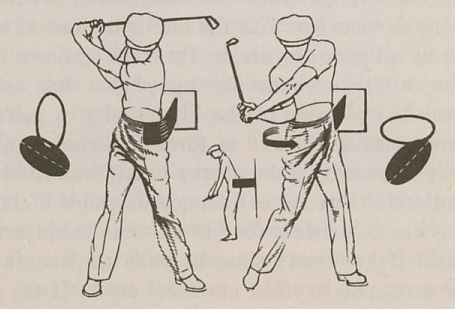
Ben Hogan's elastic strip idea - from reference number [3]
During the backswing, the elastic strip becomes stretched when the left pelvis moves away from the tush line. Then, during the early downswing, the left pelvis gets pulled back towards the tush line as the elastic strip snaps back. Note that there is no deliberate sliding motion of the pelvis left-laterally towards the target - the pelvis only moves a few inches leftwards when the left leg becomes progressively more weighted during the early downswing. Note that left leg primarily gets weighted on the left heel, and not the left forefoot, during this left hip clearing action - when the left buttocks gets pulled back towards the tush line.Consider again this swing video of Tiger Woods' pelvic motion in the downswing - http://www.youtube.com/watch?v=4wxn0sIkJH8
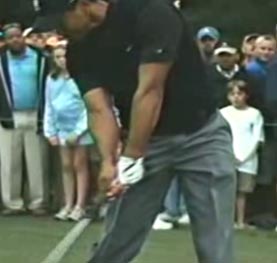
Tiger Woods at impact - capture image from his swing video
Note how open Tiger Woods' pelvis is at impact. It is very similar to that diagram from Ben Hogan's book. An open pelvis at impact is very characteristic of a golfer who starts the downswing with an assertive pelvic shift-rotation movement.Unfortunately, there is a potential downside complication that is causally associated with an assertive downswing pelvic shift-rotation movement. If a golfer has a large degree of hula hula flexibility, it is possible for the pelvis to easily outrun the upper torso and arms in the early downswing and that phenomenon can cause the golfer to get "stuck".
Tiger Woods discusses this problem in his Golf Channel video presentation with Butch Harmon - http://www.youtube.com/watch?v=PplQjd6ZP88
If you watch the entire 8 minute video segment, you will appreciate how easy it is to get "stuck" if the lower torso outraces the upper torso/arms in a golfer who has a moderate-large amount of hula hula flexibility.
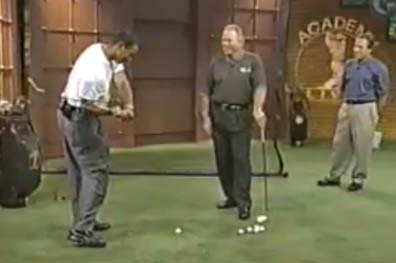
Tiger Woods demonstrating his "stuck" position - capture image from his swing video
In this video, Tiger Woods demonstrates how he can easily get "stuck" in the mid-downswing when his pelvis outraces his upper torso/arms. Tiger Woods always has to concentrate on avoiding this problem by ensuring that there is a greater degree of synchronous coordination between the movement of his torso and his arms during his downswing.Here is another video presentation, by Shawn Clement, on how to start the downswing - http://www.youtube.com/watch?v=0CSHqnYNijw
Shawn Clement talks of "falling" onto his front foot as the first action that occurs in the downswing. At the end of his backswing, his weight is mainly distributed over his right heel and to a lesser degree over the left forefoot. He then "falls" onto the left heel and that action starts the downswing action. This verbal/visual golf instructional presentation by Shawn Clement may resonate with certain golfers, because it may help them learn how to transfer their weight to their left foot at the start of the downswing action via a "correct" pelvic-shift rotation movement.
I personally find Shawn Clement's pelvic "falling" motion too exaggerated, and I think that amateur golfers should preferably emulate golfers who have a much "quieter" lower body movement.
I think that Stuart Appleby is a good role model for beginner golfers who are trying to improve their downswing's initiating pelvic action.
http://www.youtube.com/watch?v=_jqJ9R2LypY
Note how Stuart Appleby's pelvis moves in the early downswing.
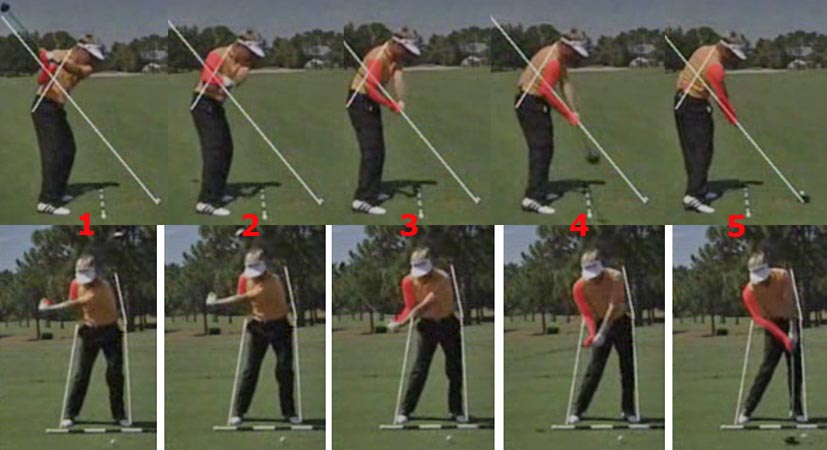
Stuart Appleby's downswing action - capture images from his swing video
Note that Stuart Appleby's pelvis only shifts a few inches to the left during the downswing. From a biomechanical perspective, it is not a left-lateral pelvic slide movement, although it can appear to occur in that manner when viewing his swing from a face-on view. What is really happening is that the i) left pelvis is being pulled back to the tush line while ii) the left leg becomes progressively more weighted (creating a firm/braced supportive left side). The fundamental biomechanical mechanism is identical to that occurring in Tiger Woods'/Ben Hogan's swing, although the entire lower body movement appears to be much "quieter".Here is another superb golfer, who has a very "quiet" lower body movement - Mike Finney - http://homepage.mac.com/brianmanzella/.Movies/mikestlocdriver05front.mov
(The swing video is an AppleQuicktime movie and requires an Apple media player).
Here is a third example of a golfer who has a "quiet" lower body shift-rotation action - Geoff Ogilvy.
http://www.youtube.com/watch?v=owamnCPutYo
Note that Geoff Ogilvy simply pulls his left buttocks back towards the tush line at the start of the downswing. Note that there is only a very small amount of left-lateral movement of the pelvis in the downswing, and that it is due to re-weighting the left leg, which then becomes progressively straightened/braced during the early-mid downswing.
The golf instructor, Brady Riggs, also emphasizes "quiet legs" in this swing video lesson - http://www.youtube.com/watch?v=bzx0tLOckiY
If a beginner golfer wants to see many examples of very good downswing pelvic movements in professional golfers, then he/she merely needs to watch a LGPA event, because many lithe, flexible women golfers have wonderfully fluid downswing pelvic movements - that are very similar to Geoff Ogilvy's downswing pelvic action.
Finally, there is a less optimum method of initiating the downswing's pelvic shift-rotation movement, which is most suitable for golfers who have zero hula hula flexibility. If a golfer has no/little flexibility of his lower thoracic and lumbar spine, then his right shoulder is going to start moving as soon as the inflexible golfer starts moving the pelvis. During the hip squaring phase of the downswing's pelvic action, the left pelvis is getting pulled back to the tush line while the right pelvis rotates slightly away from the tush line. This pelvic motion occurs mainly in a horizontal plane, and it is easy for the right shoulder to move too horizontally if the right shoulder tends to move as soon as the pelvic shift-rotation movement is initiated at the start of the downswing - due to the golfer's lack of hula hula flexibility. To prevent that phenomenon from happening, it is possible for a discerning golfer to start the downswing with an active right shoulder downplane thrust action. That action will transmit a force down the inflexible spine, which pushes the lower lumbar spine and pelvis left-laterally. As the lower lumbar spine and pelvis shifts 1-2" left-laterally against the resistance of a braced left leg (adopted at address), the golfer will develop an increased degree of rightwards spinal tilt (secondary axis tilt). That makes it easier for the right shoulder to continue to move downplane during the remainder of the downswing - because the shoulders/upper torso naturally tends to rotate perpendicularly around the rightwards tilted spine.
Whatever technique a golfer uses to initiate the pelvic shift-rotation movement, the correct kinetic sequence requires that the lower body move before the upper body. The degree of delay in movement of the upper body depends on a golfer's degree of hula hula flexibility and his adopted technique of starting the downswing's pelvic movement. It is important to realise that although the pelvic shift-rotational movement initiates the downswing, it doesn't power the swing. It simply initiates the optimum kinetic sequence, and it is the rotating upper torso that primarily powers a left arm swinger's swing action - by inducing the release of PA#4. In my downswing chapter (and some other review papers) I described how the entire power package gets pulled down intact towards waist level by the pelvic shift-rotation action. To keep the power package intact, a golfer also has to i) actively adduct the right arm towards the right side of the torso so that the right elbow can be actively driven to its pitch position in front of the right hip, and ii) actively drive the right shoulder downplane so that the distance between the right shoulder and the hands doesn't increase in the early downswing. If the "right shoulder-to-hands" distance remains relatively constant, then it means that PA#4 is still loaded. At a certain time-point in the mid-downswing, the shoulder (upper torso) rotation slows down and the left arm is blasted away the chest wall in a downwards-and-forwards direction towards the ball. That represents the active release of PA#4. The amount of energy (derived from the pivot-drive action) used to unload PA#4, and release the left arm, should be sufficient to allow the left arm to freewheel through impact to the end of the followthrough - it should "feel" like the motion of throwing a frisbee backhanded. The pivot-drive action does not need to supply additional swing power energy during the late downswing, and a golfer should feel that the left arm is simply freewheeling through impact. A golfer also needs to "feel" that the release of PA#2 (uncocking of the left wrist) and release of PA#3 (rolling of the left hand into impact) occurs passively/naturally. A left arm swinger does not need push-power from the right arm/forearm to actively induce the release of PA#2 or PA#3. It will happen automatically/naturally/passively if PA#4 is released with enough energy by an efficient pivot-drive action.
Many high handicap, left arm swingers have a very inefficient pivot-drive action and they do not release PA#4 with sufficient power in the early-mid downswing, and the left arm slows down too much before impact. Those golfers can sense that the left arm is moving too slowly in the late downswing, and they tend to use an active right arm/forearm push action in the late downswing as a compensatory action. This is a major swing fault, because the over-active right arm push action in the late downswing may i) push the hands too fast into impact and/or ii) interfere with the centrifugal release of the clubshaft (release of PA#2) and/or iii) over-roll the left hand during the release of PA#3. A better choice for a left arm swinger would be i) learning how to improve the efficiency of the pivot-drive action, or ii) choosing an alternative swing style if the pivot-drive action continues to be insufficiently effective.
Arm, wrist and hand movements in the downswing
In the early downswing, the arms are passive and the entire power package (loaded left arm flying wedge and loaded right forearm flying wedge and right shoulder) gets pulled down to waist level as a result of the pelvic shift-rotation movement that initiates the downswing. One can see that phenomenon happening in Stuart Appleby's downswing images - see above. Note, in image 3, that the right elbow is still bent at a right angle, and note that the right forearm is still at right angles to the left arm flying wedge. For the power package to remain intact, the right shoulder must be actively moving downplane and the right upper arm must be actively adducted towards the right side of the torso, so that the right elbow can reach its pitch position in front of the right hip - image 4. Swing power is generated during the early downswing (images 1-3) by the pivoting torso, which pulls the left arm downwards-and-forwards towards the ball. PA#4 release occurs in the mid-late downswing (images 3-5) and during this release phase (unloading of PA#4) the passive/inert left arm has enough energy to freewheel towards impact, and through impact to the end of the followthrough. The passive/freewheeling left arm pulls the club, which releases passively via a centrifugal action (release of PA#2) - image 4/5. In the late downswing, the left arm passively externally rotates and the left forearm passively supinates, so that the flat left wrist faces the target by impact (release of PA#3) - image 5. The swiveling of the straight left forearm and flat left wrist/hand into impact is called the release swivel action, and it occurs passively/naturally/automatically. A golfer doesn't have to contrive/force this phenomenon to happen, because the left arm naturally wants to swivel back to its neutral position - the natural position of the left arm when it hangs naturally in front of the left shoulder at address. In the neutral position, the left arm is neither internally rotated or externally rotated, and the left forearm is neither supinated or pronated. Image 5 shows Stuart Appleby's left arm/forearm in its neutral position at impact.
During the mid-late downswing, the right elbow must straighten with enough active isotonic force, so that the right hand can keep up with the left hand - images 4/5. During this phase of the downswing, the right palm is applying a small amount of push-pressure on the left thumb at PP#1 to keep the left arm straight (extensor action). However, the right arm must not straighten excessively fast in the mid-late downswing, so that it forces the left hand/grip to move faster than the left arm is already pulling the left hand/grip downwards-and-forwards towards impact. This is a critical point! The left arm/hand has already acquired enough energy to move at the "correct" speed during the mid-late downswing, and a golfer doesn't need to apply an additional push-force with the right arm/hand to move the grip end of the club at a faster speed. If a left arm swinger has an irrepresible urge to use the right arm in the mid-late downswing to speed up the movement of the grip end of the club by applying an additional push-force (at PP#1), then it usually signifies that the left arm was not moving adequately fast due to an inefficient pivot action. A left swinger swinger must correct this problem by improving his pivot-drive action so that PA#4 is released with sufficient force, so that the inert/passive left arm has enough energy to freewheel through the impact zone without any need for an additional push-force.
View this left arm-only swinger's video again if you need a visual reminder of an excellent left arm swinger's pivot-drive action - http://www.youtube.com/watch?v=uUTk7m5PozQ
That left arm-only swinger doesn't need a right arm to supply an additional push-force to the grip end the club in the downswing. His left arm is pulling the left hand/grip end of the club sufficiently fast through the impact zone - due to a very efficient release of PA#4 that is secondary to his very efficient pivot-drive action.
So, what should the right arm be doing in the mid-late downswing and followthrough from a swing power perspective?
Ben Hogan, in his book [3], used an analogy that can give a left arm swinger a "feeling" of what the two arms/hands should be "feeling" in the mid-late downswing and followthrough.
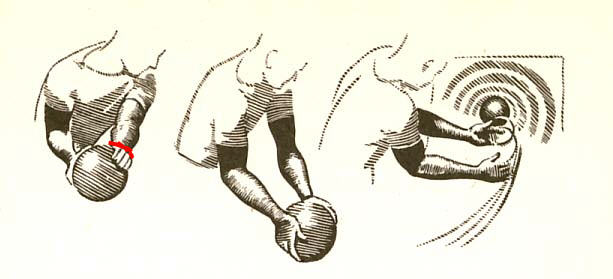
Two-handed basketball pass - from reference number [3]
Ben Hogan stated that when a person performs a two-handed pass of a basketball from the right side of the body towards a target placed about 10' in front of the body, that the person should "feel" that the left hand is moving at exactly the same speed as the right hand. Ben Hogan used this "two handed basketball pass" analogy to state that the left hand must hit as hard as the right hand through the impact zone.I prefer to not think of the left hand's action as a "hit" action. Imagine the above analogy with a slight difference - imagine that there is a 6" cloth strap handle attached to the front of the ball (attached at the two ends of the 6" cloth strap) and that the ball thrower could slide his left hand under the strap - see curved red line added to the above diagram. Then, he would experience a sensation of the left hand pulling the ball when he pivots his torso counterclockwise to the left and throws the ball towards the target. To perform the throw action with maximum fluidity/efficiency, the right arm/hand must be simultaneously pushing on the back side of the ball with enough push-force so that the thrower never experiences the "feeling" that the ball is being pulled forward faster (by the left hand) than it is being pushed forward (by the right hand). In other words, while the left hand is pulling the ball, the right hand must be pushing the ball and the forces need to be relatively balanced for the throw action to be maximally smooth.
I believe that a left arm swinger should experience the same "feeling" in the late downswing and followthrough - the "feeling" that the left hand is pulling the grip end of the club (due to the release of PA#4), but that the right hand is pushing against the left hand/grip (at PP#1) with enough push-force so that the right hand can always keep up with the left hand. I previously used the term "switting" in my review paper on How to Power the Golf Swing, and the word implies that the swinger is trying to produce more swing power by adding an additional push-force to the swing with the right arm/hand - beyond the push-force needed to allow the right hand to keep up with the left hand. The term "switting" does not mean that a left arm swinger should not use any right arm/hand push-force in the downswing, because an efficient downswing action requires the right arm to straighten with enough isotonic force in the late downswing to allow the right hand to always keep up with the left hand.
It is actually quite surprising how fast the right arm must straighten in the late downswing and followthrough to allow the right hand to keep up with the left hand as the hands pass through the impact zone. In fact, some golfers do not move their right shoulder far/fast enough downplane and/or do not straighten their right arm fast/actively enough to ensure that the right hand keeps up with the left hand. The end-result is that the right palm loses contact with the left thumb/grip (at PP#1) in the early followthrough.
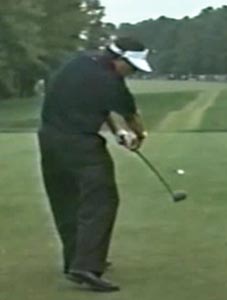
Phil Mickelson as a right-handed golfer - due to reversing the capture image obtained from a swing video
Considering Phil Mickelson as a right-handed golfer, note that Phil Mickelson's right palm has lost contact with the left hand/grip. The reason is that his left hand is moving leftwards so fast (during the followthrough phase of horizontal hinging) that the right hand cannot keep up with the left hand - despite the fact that the right shoulder has moved downplane and the right arm has fully straightened. The same phenomenon can be seen in VJ Singh's and Fred Couples' swings. Why does it happen?In my swing video lesson, I demonstrate (using badminton racquets) how fast, and how far, the left hand moves inside-left in the followthrough if a left arm swinger uses horizontal hinging.
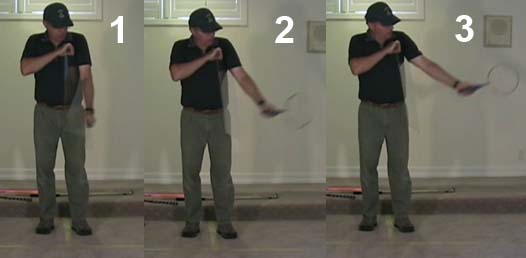
Author demonstrating the natural movement of the left arm during the followthrough - capture images from his swing video lesson
In this composite photograph, I am using a badminton raquet to demontrate the natural movement of the left arm during the followthrough phase of the swing. I am standing erect for demonstration purposes, and I have placed a clear sheet of rigid plastic in my left armpit. The rigid plastic sheet represents (symbolically) a vertical hinge in my left shoulder socket, and a reader needs to imagine that the left arm moves inside-left during the followthrough phase of the swing - as if there is vertical hinge joint in the left shoulder socket joint. During this movement of the left arm, the left upper arm/left forearm/flat left wrist and clubface move at the same rpm. That means that the back of the flat left wrist remains vertical to the ground during the followthrough phase of the swing. At the end of the followthrough, when the toe of the club is pointing upwards and the clubface is parallel (or close to parallel) to the ball-target line, the back of the flat left wrist will be vertical and parallel (or close to parallel) to the ball-target line - image 3. Note that there is no independent rotation of the left forearm during the followthrough phase of the swing. If the left forearm supinated/rotated independently during the followthrough phase of the swing - independent of the left upper arm's rotary movement in the left shoulder socket - then the back of the flat left wrist would face the ground soon after impact. That phenomenon should never happen during the followthrough phase of the swing, and it only happens during the finish swivel phase of the swing (which only happens after the followthrough phase is completed).Note how far the left hand has moved inside-left during the followthrough phase of the swing - from its position in image 1 to its position in image 3. A golfer needs to realise that the right hand has to move the same distance in the same period of time.

Author demonstrating the movement of the right hand during the followthrough phase of the swing - capture images from his swing video lesson
At impact (image 1), the left wrist is flat and the right wrist is bent (the two badminton racquet faces should actually be parallel to each other at impact). Image 2 shows the position of the left hand at the end of the followthrough phase of the swing - if a golfer uses a natural horizontal hinging action.Images 3 and 4 show the range/amount of movement of the right shoulder, right arm and right hand that is required during the followthrough phase of the swing. In other words, the right hand has to move fast/far to get to the end of the followthrough with a slightly bent right wrist (which is desirable), and the right shoulder must move very actively under the chin to ensure that the golfer doesn't run-out-of-right arm. If the right shoulder doesn't move far/fast enough due to a slightly sluggish post-impact pivot action and/or if the right arm doesn't straighten fully post-impact, then the right hand will not be able to keep up with the left hand (as can be seen in the Phil Mickelson photo demonstration) or the right wrist will passively straighten in the late followthrough. It is acceptable, although not necessarily desirable, to allow the right wrist to passively straighten in the late followthrough, as long as it doesn't prematurely straighten through impact. If the right wrist straightens prematurely, prior to impact, it will produce flipping of the clubshaft. A golfer must always avoid flipping by ensuring that the right wrist never straightens pre-impact, during impact or immediately post-impact, and he must ensure that any passive right wrist straightening (if any) only occurs in the late followthrough.
Some golf instructors incorrectly advise golfers to actively straighten the right wrist through impact.
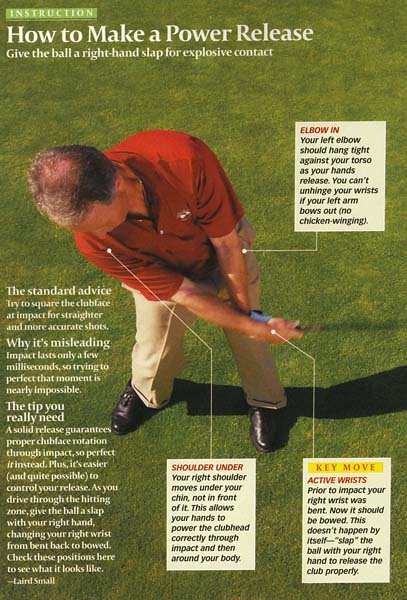
Laird Small's power release idea
Laird Small is a top-100 golf instructor, who incorrectly believes that the right wrist must actively straighten through impact - see his "key move" in the above photo from Golf Magazine. He believes that a golfer must actively slap the ball with the right hand to release the club properly. I think that he is 100% wrong! A golfer should never use that active slap hinge action during impact. First of all, it requires perfect timing to avoid flipping through impact, and secondarily, it doesn't really add any power to the swing.So, how should a golfer execute what Laird Small calls a "power release"?
The word "release" is one of the most confusing concepts in the world of golf instruction, and if you ask 10 golf instructors what they mean by the term "release", you will likely get 10 different answers.
I will explain what I mean by the term "release".
There are two factors to consider during the "release" action - the movement of the clubshaft and the movement of the arms/forearms/wrists/hands.
There is little controversy regarding the appropriate release of the clubshaft. Virtually all golf instructors believe that the clubshaft should centrifugally release in the late downswing (due to the passive release of PA#2) in a swinger's action, so that the clubshaft becomes straight-in-line with the left arm soon after impact. However, major disagreements exist among golf instructors regarding the biomechanical actions needed to induce the "release" phenomenon.
Consider Hank Haney's (another top 100 golf instructor) opinion regarding the "release" action.
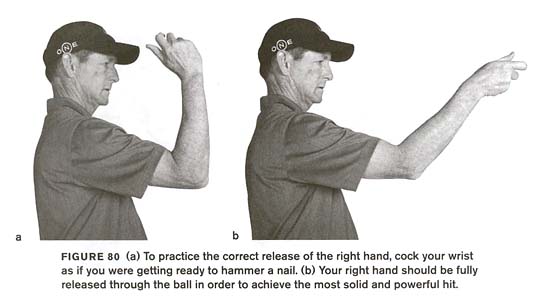
Hank Haney's opinion regarding the right hand's "release" action - from reference number [2]
In his recent book [3], Hank Haney makes the following statement with reference to the right hand - "the right hand should be fully released through the ball in order to achieve the most solid and powerful hit". I think that he is totally wrong for many reasons. First of all, he demonstrates a downcocking motion of the right wrist as representing the "appropriate" right hand release action. However, I believe that the right wrist should never be in an upcocked position in the late downswing - just prior to impact. The right wrist should only be dorsiflexed (bent backwards) at that time point in the late downswing. Secondly, the right wrist should never straighten through impact (as suggested by Laird Small) because that would predispose to flipping if the timing-of-right hand release is incorrect. Thirdly, there is very little potential power in the release of the right hand, because the bent right wrist should not be thought of as a power accumulator, that can generate swing power when released.Swing power is generated by the release of one-or-more of the four power accumulators - PA#4 (release of the left arm through the pivot-drive action); PA#2 (centrifugal release of the club through the passive uncocking of the left wrist); PA#3 (roll-over of the left hand through impact) and PA#1 (release of the bent right elbow). In other words, the "release" phenomenon should be thought of as the release of swing power through biomechanical actions, and those biomechanical actions involve biomechanical movements at the level of the left shoulder socket (release of PA#4), left wrist (passive release of PA#2), left forearm (release of PA#3) and right elbow (release of PA#1). There is no "release" phenomenon involving the right wrist, which should remain bent through impact. It is only acceptable to allow the right wrist to passively straighten in the late followthrough, and it should never actively (or passively) straighten during impact or immediately post-impact. The endpoint for the complete release of the four power accumulators is the end of the followthrough (when both arms are straight - position 3 in the next upcoming photo of Aaron Baddeley's swing).
I think that Hank Haney, like many top 100 golf instructors, is also wrong regarding the biomechanics involved in the release of PA#3.
The release of PA#3 is the roll-over of the left hand into impact. At impact, the back of the flat left wrist/hand must be vertical and level and facing the target. To get to that position, the flat left wrist/hand must undergo a roughly 90 degree rotation as the club moves from the delivery position (third parallel) to the impact position, and this represents the release swivel action.
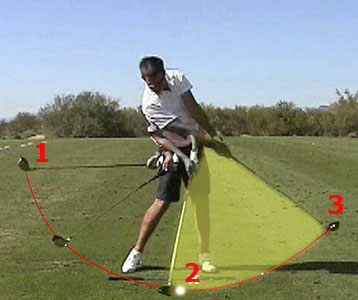
Release swivel phase (1-2) and followthrough phase (2-3) of Aaron Baddeley's swing - capture image from his swing video
The release swivel phase of the downswing occurs between position 1 and position 2 in the above photo. During this time period, the clubshaft is releasing and becoming more straight-in-line with the left arm due to a passive uncocking action involving the left wrist (release of PA#2). However, the clubshaft is also rotating so that the clubface will face the target at impact. The major biomechanical action causing the roughly 90 degree rotation of the clubface and the back of the flat left wrist/hand is a left forearm supinatory movement. In other words, the rotary movement is primarily happening at the level of the left forearm, and the fulcrum of the movement occurs at the level of the left elbow. The left radius bone rotates (swivels) over the left ulna bone, and that action represents the left forearm supinatory action. The endpoint for the left forearm supinatory movement occurs at impact - when the left forearm is in its neutral position (when the left forearm is neither supinated or pronated from its natural/neutral position). There should be no further supination of the left forearm beyond its neutral position during the immediate post-impact phase of the followthrough.Many golf instructors, like Hank Haney, seemingly believe that the left forearm must continue to supinate (beyond its neutral position) post-impact.
Here is Hank Haney's description from his recent book [2].
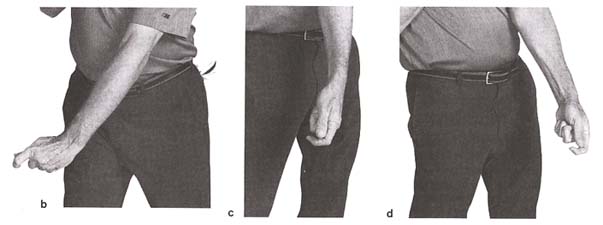
Hank Haney demonstrating the the release action involving the left hand - from reference number [2]
Hank Haney states in his recent book [2] with reference to the above photo sequence - "b. Hinge the left wrist as you swing back. c. Square the back of your left hand at impact. d. Your left hand continues to supinate through the ball."I believe that Hank Haney is wrong about the left hand continuing to supinate after impact. If the left hand continued to supinate after impact, then the back of the left hand would face more groundwards - because supination is a rotary movement involving the left forearm, where there is independent left forearm motion occurring below left elbow level. However, that independent left forearm supinatory motion doesn't happen in a good golfer's followthrough. What actually happens is that the left upper arm, left forearm, flat left wrist/hand rotate at the same rpm (as a single unit) due to external rotation of the left humerus in the left shoulder socket, while the left shoulder socket is moving inside-left after impact - and this action is called a horizontal hinging action. During a horizontal hinging action, the back of the flat left wrist/hand should remain vertical to the ground, and it should never face groundwards (which would predispose to duck-hooked shots if a golfer's timing was off).
I suspect that Hank Haney, like many other golf instructors, acquired this "belief about a supinating left wrist" from Ben Hogan's groundbreaking golf instructional book [3] where Hogan described what he thought was happening to his left hand through impact.
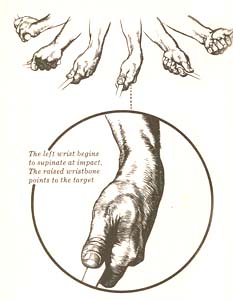
Hogan's left hand supination diagram - from reference number [3]
Hogan thought that his left hand continued to supinate post-impact, and he produced the above diagram showing the back of the left wrist/hand facing slightly groundwards during the post-impact followthrough phase of the swing. Although Hogan described the "rotary feeling" as a supination action, his flat left wrist/hand actually remained vertical to the ground when he employed a horizontal hinging action. Hogan also used the term "supination" when referring to his left wrist at impact, but that arched position of the left wrist (where the wrist bones are raised) is due to the wrist being in a state of palmar flexion, and not a state of supination. Supination is a left forearm action, and not a left wrist action. The left wrist's positional alignment is not affected by the biomechanical action of supination - and the left wrist and left hand are affected equally by a left forearm supination action, because the supination action involves the rotation of the forerarm radius bone around the longitudinal axis of the forearm ulna bone.
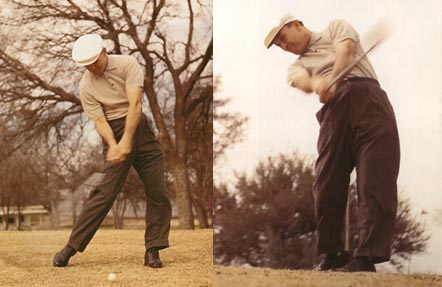
Hogan's left hand movement through impact - from reference number [6]
It is difficult to find good quality photos of Ben Hogan's left hand movement during the followthrough phase of his swing, and the above photograph is the "best" photo that I have ever found.Note that he is using a horizontal hinging action during the followthrough phase of his swing - note that the toe of his club is pointing straight-up and note that the clubface is horizontal to the ground. Most importantly, note that the back of his flat left wrist/hand is vertical to the ground, and he has not supinated his left hand beyond its neutral position - note that the radial border of his left forearm is facing skywards (and not leftwards). However, the left hand has continued to rotate post-impact due to a horizontal hinging action, which happens, from a biomechanical perspective, at the level of the left shoulder socket - and where the entire left upper arm, left forearm and flat left wrist/hand rotate at the same rpm. There is no independent supination of the left forearm, which would be disadvantageous, because it could produce over-rolling of the left hand and predispose to duck-hooked shots if a golfer's timing was off.
I have never previously discussed the issue of "timing" in my previous review papers, but "timing" is of critical importance in a left arm swinger's swing action.
There are two terms that require a precise definition - "tempo" and "rhythm" - and I will describe my use of those two terms from a golf instructional perspective.
I believe that the term "tempo" refers to the overall speed of the swing - how long it takes a golfer to complete the backswing and/or downswing. Golfers who have a fast tempo complete the backswing and/or downswing phase of the swing faster. It is an individual swing characteristic - similar to a golfer's walking speed. Some golfers naturally prefer to walk faster than other golfers, and some golfers naturally prefer to swing faster than other golfers.
I believe that the term "rhythm" refers to the synchronous coordination-of-movement of the i) piovting/rotating torso, the ii) swinging arms and the iii) the swinging clubshaft from an angular rotational perspective.
I think that a golfer should think of the golf swing as a rotational movement and the idea is to execute a perfectly synchronised swing - where there is a "feeling" that the arms and clubshaft remain in front of the rotating torso at all times throughout the downswing and followthrough. A golfer should avoid having the arms traveling faster/slower than the rotating torso (from a rotational perspective) and he should avoid having the clubshaft traveling faster/slower than the arms (from a rotational perspective) - especially in the impact zone (between the 3rd and 4th parallels).
Consider a visual example of "rhythm".
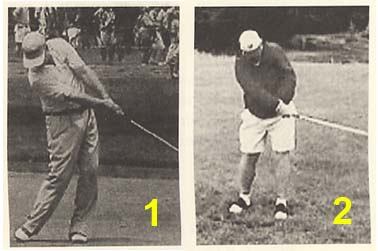
Two golfers - from reference number [7]
Consider the two golfers from the perspective of "rhythm".The golfer in photo 1 has good rhythm-: i) Note that he has pivot-rotated his torso well through impact so that his navel points about 45+ degrees to the left. ii) Note that his swinging arms are rotating at the same speed as his rotating torso - an imaginary line drawn equidistant between the two straight arms points at his navel. iii) Note that his clubshaft is swinging at the same rotational speed as his swinging arms and rotating torso - the butt end of the clubshaft points at his navel.
The golfer in photo 2 has poor rhythm-: i) Note that his torso has stalled at impact and his navel is facing the ball-target line. ii) Note that his arms have traveled faster than his rotating torso. iii) Note that his clubshaft has traveled faster than his arms.
This chosen photo-comparison example is a deliberate exaggeration designed to make an important golf instructional point. The important golf instructional point is that a left arm swinger must swing rhythmically through impact, so that that he can look like the golfer in photo 1 by the end of the followthrough (defined as the time-point when both arms are straight). I believe that a major factor that allows a golfer to have perfect "rhythm" through the impact zone is the factor of an "efficient pivot-rotation action" - a golfer must continue to efficiently rotate his torso after impact. Many high handicap golfers stall their pivot at impact, and the arms/clubshaft (which have gained considerable angular momentum) then travel faster than the torso. Consider what will happen if the torso slows down, or stalls, at impact.
In a good golfer's swing, note where the left shoulder socket will be at the end of the followthrough - see photo 1. The left shoulder socket is moving up-and-away from the ball, and that up-and-away motion of the left shoulder socket allows the left humerus to easily externally rotate in the left shoulder socket. Consider what will happen if a golfer's pivot action stalls at, or near, impact. The left shoulder socket will not be moving up-and-away from the ball, and it will therefore be harder for the left humerus to rotate easily in the left shoulder socket (which is required for a horizontal hinging action). If there is impedance to rotation of the left humerus at left shoulder socket level, then most of the rotation of the left forearm/hand/clubface will occur due to biomechanical movements happening below elbow level, at the level of the left forearm - the left forearm will supinate as the radius bone rotates around the longitudinal axis of the ulna bone. That will cause the back of the flat left wrist/hand to face more groundwards and this will predispose to duck-hooked shots (shots that fly low and leftwards) if the clubface rotates groundwards during impact.
Consider the "two-handed basketball pass" again.
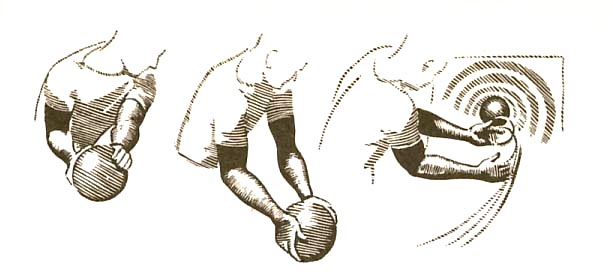
Two-handed basketball pass - from reference number [3]
Note that the ball thrower has his hands on opposite sides of the ball at roughly the level of the ball's equator. Note that when he throws the ball at the target, that the hands remain at roughly the same horizontal level - there is no counterclockwise rotation of the hands during the throw action. I believe that it is only easily possible to throw the ball in that neutral manner if the thrower rotates his upper torso well during the throw action, so that there is no impedance to external rotation of the left humerus in the left shoulder socket. If the thrower throws his arms towards the target without simultaneously rotating his torso towards the target, then his hands will likely undergo a counterclockwise motion during the throw action - the left hand will supinate towards the 6 o'clock position while the right hand will pronate towards the 12 o'clock position.
That counterclockwise rotation of the hands is not necessarily desirable in a two-handed basketball throw action towards a target that is to left of the thrower, and it is especially not desirable in a golfer's swing action through the impact zone. A golfer should never allow his flat left wrist/hand (and therefore clubface) to rotate groundwards during impact, or immediately post-impact, due to a deliberate or passively-uncontrolled left forearm rotational motion (occurring below left elbow level).
Amazingly, AJ Bonar deliberately recommends this left hand supination action through impact - see http://www.golf.com/golf/instruction/article/0,28136,1565175-1,00.html
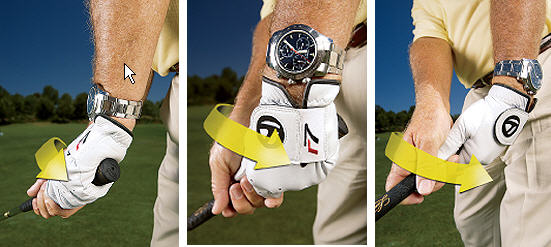
AJ Bonar's Magic Move - from his swing lesson
Note that the knuckles of his left hand are facing groundwards post-impact - image 3.
That underdesirable hand action (called a crossover hand release action) will occur passively/uncontrollably if a golfer fails to pivot-rotate his torso efficiently through impact - for reasons previously explained.
The left hand must not supinate, and the right hand must not pronate, soon after impact, and if a golfer ensures that his torso pivot-rotates efficiently post-impact, then this undersirable crossover hand release action is less likely to happen.
Here is a good example of an efficient post-impact torso rotation and an excellent horizontal hinging action (where the left arm's rotation occurs at the level of the left shoulder socket, while the left shoulder socket is moving up-and-away from the ball).
Jack Nicklaus' swing - http://www.youtube.com/watch?v=aJ87eGG0svo

Jack Nicklaus' swing action - capture images from his swing video
Note how well Jack Nicklaus rotates his torso post-impact. Note that he has excellent "ryhthm" - note that his arms remain in front of his rotating torso, and note that the clubshaft roughly points at his navel, throughout the followthrough phase of his swing. Note that the radial border of his left forearm does not rotate counterclockwise/groundwards, and note that his flat left wrist/hand remains vertical to the ground - thus demonstrating that he is not using a left forearm supinatory rotational movement during his followthrough. Note that the right forearm does not pronate the right hand over a supinating left hand during the followthrough (as occurs in an uncontrolled hand crossover release action) - note that the radial border of his right forearm faces skywards during the entire followthrough.Note that his efficient torso rotation post-impact gives one the impression that he is "swinging left". The concept of "swinging left" is often misunderstood. Jack Nicklaus is not "swinging left" - he is merely rotating efficiently post-impact, so that he can keep the clubshaft on his "selected" impact plane from impact to the 4th parallel. Many golfers do not keep their clubshaft on their "selected" impact plane post-impact and they allow the clubshaft to centrifugally release in a direction that is slightly to the right of the target.
Look at Kevin Na's driver swing in this swing video - http://www.youtube.com/watch?v=E0EKksPTyk0

Kevin Na "swinging left" - capture images from his swing video
If one looks at this swing video of Kevin Na's swing at a normal speed, it may appear that he is flinging his club centrifugally down-the-line in a direction that is slightly right-of-the-target. However, when studying his swing frame-by-frame using a swing analyser program, one can see that he is keeping the clubshaft on his selected plane through the impact zone. Image 1 shows Kevin Na's clubshaft in the mid-downswing, and he is progressively shallowing his clubshaft from the TSP to the elbow plane. His clubshaft reaches the elbow plane when he gets to the delivery position (3rd parallel). His clubshaft then remains on the elbow plane during the release swivel phase of the downswing and it is on the elbow plane at impact (image 2). At the end of the followthrough (image 3), his clubshaft is still traveling along the elbow plane. Image 4 shows the time-point when his hands disappear from view as the club passes the 4th parallel. Note the movement of the left shoulder between image 2 and image 4 - the left shoulder is moving up-and-away due to his continued post-impact torso rotation, and his excellent torso rotation allows him to execute a horizontal hinging action while keeping the clubshaft on-plane. His clubshaft should not be moving inside-left sooner after impact, because that would mean that he is pulling his clubshaft off its selected plane of travel - a plane intermediate in steepness between the elbow plane and the turned shoulder plane plane. If a golfer selects to swing on a shallower plane (eg. impact zone plane that is closer to the hand plane than the elbow plane) through the impact zone, then his hands will disappear from view sooner (when viewed from a down-the-line view). The hands will also move inside-left sooner when a golfer uses a short iron, because the clubhead swingarc has a smaller radius and the hands are held closer to the body.
The concept of "swinging left" after impact should therefore be understood as being the appropriate biomechanical actions that a golfer needs to execute to efficiently keep the clubshaft on his selected plane as the clubshaft moves through the impact zone - from the 3rd parallel to the 4th parallel. A key part of those "appropriate biomechanical actions" is the biomechanical fact that a golfer needs to continue to actively pivot-rotate to the left post-impact, so that the left shoulder moves up-and-away. The movement of the left shoulder socket up-and-away (inside-left) allows a golfer to efficiently perform a horizontal hinging action while keeping the clubshaft on the selected plane. When the club is released in the late downswing, it is moving in-to-out towards impact at a very fast speed, and it requires a very efficient post-impact pivot rotation (inside-left movement of the left shoulder socket) to keep the clubshaft on the selected impact plane between impact and the 4th parallel. The "feeling" that a golfer should experience when performing this appropriate post-impact pivot-rotation action is the "feeling" of "swinging left". If a golfer "swings left" with maximum efficiency during the followthrough, then the golfer should be able to effortlessly transition from a horizontal hinging action into a finish swivel action, that ultimately leads to an efficiently completed finish action.
When a golfer "swings left" there are variations in swing style because of the variable element of timing/rhythm. I previously stated that the optimum swing, from a rhythm perspective, has an optimally synchronised coordination of movement between the rotating torso and the rotating arms. If one looks at Kevin Na's swing, one can see that his arms are not moving in perfect rotational synchrony with his rotating torso during the downswing and followthrough - although he is "swinging left". The best swing example of perfect synchrony (optimum rhythm) that I have ever seen is Ben Hogan's swing.
See - http://www.youtube.com/watch?v=LJdChWnxDvU
Note how synchronously he rotates his arms/torso throughout the downswing and followthrough. Ben Hogan is "swinging left" with perfect rhythm, and I think that he remains a perfect role model for modern-day golfers.
Here is an example of a golfer who seems to be "swinging left" to a greater degree than most professional golfers.
Hunter Mahan - http://www.youtube.com/watch?v=YLxfropD-FU

Hunter Mahan "swinging left" - capture images from his swing video
In this series of photos captured from his swing video, it appears that Hunter Mahan is "swinging left" sooner than most professional golfers - note how his hands are disappearing around the left side of his body in the late followthrough (image 4).The reason for that visual phenomenon is that Hunter Mahan's selected impact plane is shallower than usual - note that his clubshaft is just above the hand plane at impact (image 1) - compared to Kevin Na, whose clubshaft is closer to the turned shoulder plane at impact (see image 2 in the photo series of Kevin Na's swing above). When Hunter Mahan "swings left" he is doing nothing more than staying on his selected impact plane during the followthrough (images 2, 3 and 4), and he "appears" to be "swinging left" more than most professional golfers because his selected impact plane is shallower than average. I think that it is advantageous for a golfer to select a shallower impact plane, because it means that a golfer is more likely to remain more "rhythmically connected" during the downswing and followthrough (like Ben Hogan and Hunter Mahan) - a swing scenario where the arms and body are more synchronously coordinated as the golfer swings through the impact zone (from the 3rd parallel to the 4th parallel).
Right arm swinging and hitting
Introduction
In this section, I am going to be describing right arm swinging for the first time. I have previously discussed the hitting technique in my How to Power the Golf Swing review paper, and I am not going to discuss the hitting technique again in great detail. I am mainly going to point out certain features of hitting, so that a golfer can clearly get to understand the differences between hitting and right arm swinging. The hitting technique was apparently first described by Homer Kelley in his book called "The Golfing Machine" [8]. I am therefore going to use the term TGM-hitting as indicating that I am describing the hitting technique in a way that was specifically recommended by Homer Kelley. Homer Kelley briefly mentioned the possibility of a golfer using a right arm swinging technique, but he never described his right arm swinging approach in any detail in his book, and there is no "golf standard" source of solid TGM-based information on right arm swinging. I only know of three golf instructors who teach/taught right arm swinging - the late Tom Tomasello, Gary Edwin (in Australia) and Peter Croker (in Australia). I personally found their descriptions of right arm swinging unclear and of limited help, and in this review paper, I will be describing my personal approach to right arm swinging.
I believe that right arm swinging is particularly suitable for golfers who cannot pivot well due to a lack of torso/spinal flexibility and who cannot easily keep their left arm straight throughout the backswing and downswing. I believe that a well executed pivot action is essential for a left arm swinger, but less critical for a right arm swinger, who doesn't use a pivot-drive action to power the swing.
The best analogy that I can envision that will allow a golfer to clearly understand the difference in "feeling" between left arm swinging and right arm swinging is to compare the "feeling" of throwing a frisbee backhanded with the left arm (which is analogous to left arm swinging) to skipping stones with the right arm (which is analogous to right arm swinging). When a frisbee thrower performs a backhanded frisbee throw action, he first turns his torso away from the target and loads the left arm across the upper torso. He then starts the throw action by rotating his torso fast in the direction of the target, starting the pivot action from the bottom-up (lower body moves first and upper body moves secondarily). The inert left arm (which simply acts as an inert lever) is then catapulted in the direction of the target by the fast rotating torso. The torso rotation supplies the throw power, and the left arm is basically inert from a throw-power perspective.
By contrast, consider the throw action of a right-armed stone skipping individual. The major preparatory action involved in stone skipping is a preliminary loading of the right arm by withdrawing the right arm away from the torso, so that the right hand ends up in a positional location somewhere near the right shoulder. The right arm throw action in stone skipping can be perceived to be a side-throwing, slightly underhand, right arm throw action. During this throw action, the stone skipper can use an active pivot action or a reactive pivot action. In an active pivot action, the stone skipper will first take a step forward with the left leg and initiate a pivot action before the right arm throws - similar to the right arm throw action of a baseball pitcher. In a reactive pivot action, the stone skipper will brace his left leg, and throw his right arm across the front of his rotating torso, while using the resistance of a braced lead leg to stabilise/control/direct the reactive pivot action. Both pivot actions work very well, and each individual stone skipper can choose the pivot action which works best for him. Interestingly, all three of those previously-mentioned golf instructors, who teach right arm swinging, recommend a reactive pivot action. I have personally experimented with both types of pivot action, and I personally perform "right arm swinging" much better when using a reactive pivot action (which I will describe in great detail at a later stage in this review paper).
TGM-hitting and right arm swinging have one biomechanical phenomenon in common - both techniques use the right arm to power the swing. However, there are major differences in technique. A TGM-hitter mainly powers the swing via a straightening action of the right arm (representing the active release of PA#1) and a TGM-hitter provides a constant push-force against the back/aft side of the grip end of the club throughout the mid-late downswing. Because a TGM-hitter is applying the constant push-force against the club's grip (at PP#3 and at PP#1 via the palm of the right hand, which sits over the left thumb), a TGM-hitter is drive-loading the club. When drive-loading a club throughout the downswing, a TGM hitter is over-riding the club's centrifugal release action (due to the passive release of PA#2) that normally occurs if a golfer uses a swinging technique. A hitter usually uses a triple barrel power accumulator swing action - 1:2/3 - and the straightening right arm actively releases all three of those power accumulators. By definition, a right arm swinger is still using a swinging technique, where the power accumulator use/release sequence is 4:2:3. In a swinging technique, it is only the release of PA#4 that is active, while the release of PA#2 and PA#3 is passive. In a left arm swinger, the pivot -drive action actively releases PA#4, while in a right arm swinger, the right arm releases PA#4. In other words, a right arm swinger uses the right arm to release the left arm, and the right arm basically pushes the left arm forward via push-pressure at PP#1 (located at the base of the left thumb of the left hand), and the pushed left hand then pulls the club via its left hand grip attachment (at PP#2).
Another major difference betweeen TGM-hitting and right arm swinging, is the timing of the right arm push-force action. In TGM-hitting, the right arm push-power is mainly activated in the mid-late downswing - when the right arm straightens at the right elbow joint. By contrast, in right arm swinging, the right arm push-power is activated in the early downswing - prior to straightening the right elbow joint. To better understand this point, one needs to better understand the fundamental biomechanics of the TGM-hitting and right arm swinging actions. In TGM-hitting, swing power is primarily generated when the right arm actively straightens in the mid-late downswing. The right shoulder is the launching pad for the right arm straightening action, and it acts as a backstop for the active release of PA#1. A triple-barrel TGM-hitter primarily moves the right shoulder downplane in the early downswing, so that the right shoulder can get closer to the ball, before PA#1 is actively released. If PA#1 is released too soon, a TGM-hitter will run-out-of-right arm. A key feature of a TGM-hitter's swing action is the fact that the right arm must still be slightly bent at impact, and the right arm must only be fully straight by the end of the followthrough. That biomechanical requirement means that the right shoulder must be sufficiently close enough to the ball at impact, so that a TGM-hitter doesn't run-out-of-right arm. A TGM-hitter can also supply a certain degree of right shoulder thrust action to his right shoulder's downplane movement, and some TGMers regard that additive right shoulder thrust action as contributing to a TGM-hitter's four-barrel swing action (4:1:2/3). In right arm swinging, the golfer activates the release of PA#4 (release of PA#4) via swing power derived from the right shoulder and right arm (and not via a pivot-drive action). To better understand this point, first consider how energy is supplied to the left arm in order to activate the release of PA#4 in a left am swinger's action.
Consider Ben Hogan's left arm swingers' action - http://www.youtube.com/watch?v=QL_6M_xZvq0

Ben Hogan's release of PA#4 action - capture images from his swing video
I have plotted Ben Hogan's left hand arc movement in the above composite photo - derived from capture images from his swing video. I have divided his left hand arc movement into two stages - stage 1 (image 1 and image 3) represents the first part of the hand arc motion, and during this time period, the distance between the left hand and the right shoulder remains constant. In stage 2 (image 2 and image 4) the distance between the left hand and right shoulder progessively increases and this stage represents the release of PA#4 (release of the left arm). The energy used to power the release PA#4 is derived from biomechanical actions occurring in stage 1. Which biomechanical actions occurring in stage 1 are primarily responsible for providing the swing power needed to power the release of PA#4 (that subsequently occurs in stage 2)?
Consider what happens in stage 1 of Ben Hogan's swing. Ben Hogan states that he starts the downswing with a lower body shift-rotation movement, and he demonstrates this action in his swing video lesson. In the first part of the swing video lesson, he performs what is called the "Pump-it Drill" about 5x - where he shifts-rotates his pelvis, and thereby pulls the entire power package (which consists of the right shoulder, the right forearm flying wedge and left arm flying wedge) down to waist level, while keeping the power package intact. The biomechanical process of keeping the power package intact means that there is no straightening of the right elbow during this process. If the right elbow doesn't straighten in stage 1, then the right shoulder, right elbow and hands (both the left hand and the right hand) are moving at the same speed. Ben Hogan implies that the lower body's shift-rotation movement supplies the power to passively move the intact power package down towards waist level. In other words, the pivot-drive action is supplying the power to move the left arm/hand during stage 1. Many TGMers think that the power comes from the pivoting torso applying a loading pressure at PP#4 (where the left arm abuts the left pectoral area of the chest wall) during stage 1. I prefer to think that it is really the 3-D movement of the left shoulder socket in space, which is pulling the left arm at the same speed, that is really responsible for supplying the swing power needed to power the release of PA#4. Conceptually, one can mentally think of a backhanded frisbee throw action using the left arm - during the first part of the throw action (stage 1), the pivot-drive action produces a torso rotation that rotates the left shoulder socket forwards very fast towards the target. The inert left arm is automatically pulled forward at the same speed as the left shoulder socket. In other words, the energy needed to move the left arm is derived from the energy needed to rotate the left shoulder socket very fast in the early phase (stage 1) of the backhanded frisbee throw action - and that energy is derived from the pivot-rotation action. At a certain time-point in the backhanded frisbee throw action, the left arm will be thrown forward and it will travel at a faster speed than the left shoulder socket, and during this phase (stage 2) the left arm will be freewheeling towards impact. In other words, the energy needed to allow the left arm to freewheel towards the target (in stage 2) was derived from the pivot-drive's biomechanical actions that happen in stage 1.
Here is another Ben Hogan swing video demonstrating this point - http://www.youtube.com/watch?v=LJdChWnxDvU

Hogan's release of PA#4 - capture images from his swing video
Images 1, 2, 3 show Hogan's shoulder and arm movements in the early downswing - prior to the release of PA#4. Note how he has squared his pelvis as a result of the pelvis shift-rotation movement that initiates his downswing. Note how much his left and right shoulders have moved in space. Note that the right elbow is moving as fast as his right/left shoulders, and note that the two hands/grip is moving as fast as the shoulders - which means that the entire power package remains intact. Note that the angle between the left arm and the chest wall has remained essentially unchanged - which means that PA#4 has not yet released. In other words, it is during this early stage of the downswing that energy is being supplied to the left arm, that will eventually supply the left arm with enough thrust energy to enable it to freewheel towards impact in the mid-late downswing.Note that PA#4 is releasing in images 4/5 - note that the angle between the chest wall and left arm is progressively increasing. Why does PA#4 release at that particular time-point in the downswing? I believe that it is causally due to the fact that the shoulders are becoming square to the ball-target line, and their directional thrust action downwards-and-forwards in the direction of the ball has now reached the zenith of its velocity-travel in that direction. The shoulders will keep on rotating actively in the mid-late downswing, but not in a direction that supplies a thrust force downwards-and-forwards in the direction of the ball. In other words, it is at this "PA#4 release" time point that the left arm gets catapulted/blasted towards impact with enough energy to freewheel through impact, and beyond impact (as occurs in that swing video of a "pure" left arm-only swinger). Note that the right elbow remains bent and note that the left arm-clubshaft angle remains unchanged during the early phase of PA#4's release - Hogan has still retained his clubshaft lag (image 4/5). Maintaining clubshaft lag, and avoiding casting, is critically important to a left arm swinger's action - as described in my review paper on How to Maximize Wrist Lag and Avoid Casting.
I believe that a right arm swinger must mimic these actions - i) activating/energising PA#4 in the early downswing and then releasing PA#4 with enough energy to allow the left arm to freewheel fast towards impact; while ii) ensuring that lag is maintained in the early downswing, so that casting is avoided - by using the right shoulder/arm, and not a pivot-drive action. I believe that a right arm swinger must get into the same position as Hogan in image 5 - note that his right elbow is approaching its pitch position in front of the right hip, and note that his right elbow has not straightened. Also, note that his left wrist is still fully upcocked, and that his right wrist is still fully dorsiflexed. How does a right arm swinger accomplish these goals?
When I studied the golf instructional advice of "right arm swinging" golf instructors, they offered no useful advice on how to accomplish these goals. In fact, their primary recommendations seemed counterintuitive, and even counterproductive - because they concentrated their golf instructional advice on a "right forearm or right hand throw action", which I believe must be preceded by a right arm-induced PA#4 loading/release procedure .
Consider what they recommend in their swing video lessons or books.
Tom Tomasello produced a swing video lesson relating to his ideas about right arm swinging at a late stage of his life [9].
At the 5 minute time-point in the chapter 1 video lesson, he starts to talk about, and he demonstrates, how to perform the "right arm swing" action - and he states-: "the right forearm must throw the clubshaft down onto the plane, and that action will uncock both wrists in a karate chop motion". What he is describing actually happens in the mid-downswing and not the early downswing. He doesn't describe how to mimic Ben Hogan's early downswing action that allows the power package to remain intact in the early downswing. I think that many beginner golfers may misunderstand his advice, and prematurely straighten their right elbow in the early downswing.
I think that Peter Croker's advice is even more problematic.
Peter Croker article in Golf Digest - http://www.crokergolf.com/golfdigestarticle1.htm
Peter Croker states that a golfer should think of throwing the clubhead at the ball as the first downswing action, and he recommends that the golfer should "feel" that he is pushing the clubhead down to the ball with the right hand.
In his book [10] Peter Croker recommends that a golfer throw the right hand at the ball.

Peter Croker's throw action - from reference number [10]
I have combined two images from Peter Croker's book. In his book, he states with reference to image 1-: "Practice swinging your right arm freely to the top"; and with reference to image 2 he states-: "Throw your hand at the golf ball".I think that it is mistake to think of throwing the right forearm (as recommended by Tom Tomasello) or throwing the right hand (as recommended by Peter Croker) down-and-out towards the ball as the primary swing thought, because that will more likely result in a premature straightening of the right arm and also increase the likelihood of casting (prematurely losing clubhead lag).
I believe that a right arm swinger must try and get to Ben Hogan's positional alignment in image 5 in this next composite photo by "feeling" that he is first throwing the right upper arm (and not the right forearm or right hand).

Hogan's PA#4 release action - capture images from his swing video
The basic idea is that a right arm swinger must mimic Ben Hogan's positional/movement actions as closely as possible - by using the right arm in a "biomechanically correct" way.
I recommend that a right arm swinger start the right arm swinging action by simultaneously i) throwing the right upper arm and ii) thrusting the right shoulder downplane, so that they move at roughly the same speed. The right upper arm throw action is actually an active adduction movement of the right upper arm towards the right side of the torso, so that the right elbow is actively driven towards its pitch position in front of the right hip. During this right upper arm throw action, it is important to maintain the same degree of right elbow bend and the same degree of right wrist dorsiflexion (like Ben Hogan demonstrates in the above composite photo), so that the right forearm flying wedge maintains an unchanged relationship to the left arm flying wedge. If the right elbow bend is maintained during this active right upper arm throw action, then the right palm will be exerting a constant push-pressure against the left hand at PP#1 in a direction that is down-and-out towards the ball - see yellow arrow in image 5. In other words, the active right upper arm throw action, combined with an active downplane thrust movement of the right shoulder (that is simultaneously happening at the same speed), is responsible for releasing PA#4 - instead of the pivot-drive action (as occurs in a left arm swinger's action).
The amount of right upper arm/right shoulder active thrust energy required during this early downswing phase of activating, and then releasing, PA#4 is the amount necessary to supply the inert left arm with enough energy to easily freewheel towards impact in the mid-late downswing. A right arm swinger must not continue to actively thrust his right palm against the left thumb at PP#1 after he reaches the delivery position (image 5 above) because it is at this stage of the downswing that the left wrist will naturally start uncocking due to a centrifugal action (PA#2 release phase). If a right arm swinger continues to actively thrust during the mid-late downswing, then he will end up drive-loading the shaft (like a hitter), because the right palm will start to apply a push-pressure against the aft side of the grip as the club releases. A right arm swinger must allow PA#2 to release passively via a centrifugal action (as occurs in a left arm swinger' action), and the right palm must not be pushing against PP#1, or against the grip, with excessive force in the mid-late downswing. In the mid-late downswing, the right elbow must start straightening (due to an active isotonic contraction of the right triceps muscle) and that active action will cause the right forearm to paddlewheel towards impact. During this "right arm straightening" action, the right palm will exert a push-force against PP#1/grip. However, the degree of push-force, that is operant during the "right arm straightening" action, should only allow the right palm to keep up with the left hand (as the left arm/hand freewheels towards impact due to the previously activated release of PA#4) while maintaining the appropriate amount of extensor action. In other words, a right arm swinger must closely mimic the power accumulator release sequence of a left arm swinger (4:2:3), and also ensure that the release of PA#2 and PA#3 is passive. If a right arm swinger attempts to actively release PA#2/3, then he will likely become a hitter, who drive-loads the shaft.
Each golfer needs to decide whether he prefers to be a right arm swinger or a hitter, and he needs to fully understand the differences in right arm action, so that he can efficiently execute the appropriate right arm actions in an efficiently time-coordinated manner. In the next section, I will describe the fundamental differences between hitting a right arm swinging in a step-by-step manner.
Biomechanics/mechanics of hitting and right arm swinging.
In this section, I am going to describe the difference in biomechanics/mechanics between hitting and right arm swinging at every stage of the swing. Note that my expressed opinions merely reflect my personal approach, which - although I perceive my personal approach to be a biomechanically/mechanically sound approach - does not represent any particular golf school's ideology.
Address:
Hitting:A TGM hitter usually starts the swing with an impact fix alignement address position. In this position, the right wrist adopts a certain amount of right wrist bend (dorsiflexion) that depends on the position of the ball relative to low point. The degree of right wrist bend is then "fixed" at address, and a TGM hitter will usually maintain that same "fixed" amount of right wrist bend throughout the backswing and downswing. The clubshaft will have forward shaft lean at address - the degree depending on ball position relative to low point. A TGM hitter will often have the right forearm in-line with the clubshaft (as seen from a DTL view).

Scott (TGM hitter) at address - capture images from his swing video
Right arm swinging:
A right arm swinger will usually prefer to hold the hands centralised between the legs in a traditional/standard manner. The right wrist will be slightly dorsiflexed at address - the amount depending on the position of the ball/hands relative to low point. The further back the hands are at address, the smaller the degree of right wrist dorsiflexion at address. The clubshaft will usually be approximately perpendicular to the ball-target at address. It is not biomechanically necessary to have the right forearm straight-in-line with the clubshaft at address (as viewed from a DTLview).
Backswing:
Hitting:A TGM hitter will use the right forearm takeaway. However, he will not utilise a takeaway swivel action during the takeaway and he will make no attempt to swivel the left hand so that the back of the left hand/clubface becomes parallel to the inclined plane during the mid-backswing. The clubface will appear to be facing the ball during the takeaway, and it will be less open to the clubhead arc during the mid-backswing.
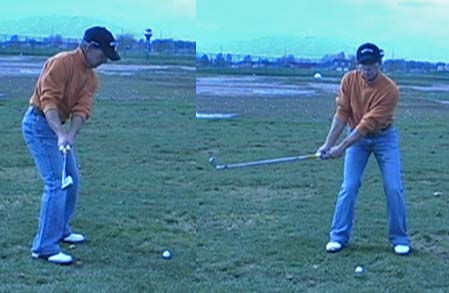
Scott (TGM hitter) at the end-takeaway position - capture images from his swing video
The desired endpoint for the hands at the end of the backswing is a positional location roughly opposite the right shoulder - this position is called the top-of-the-backswing. A TGM-hitter should not attempt to get the clubshaft parallel to the ball-target line by the end of the backswing by incorporating an additional quarter-turn rotation of the left arm to the end-of-the-backswing position (a position adopted by many left arm swingers). A TGM-hitter should distinctly "feel" like he is loading the right elbow at the end of his backswing.
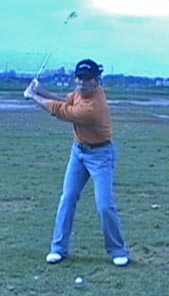
Scott (TGM hitter) at the top-of-the-backswing - capture image from his swing video
Right arm swinging:A right arm swinger will also preferably use a right forearm takeaway (which I described in detail in my How to Move the Arms ,Wrists and Hands in the Golf Swing review paper) because it will allow him to keep the clubshaft on-plane throughout the backswing, while allowing him to avoid any unnecessary right wrist upcocking movements. However, he should utilise a takeaway swivel action (like a left arm swinger), so that he can get the back of the flat left wrist/hand parallel to the inclined plane in the mid-backswing. Because he is utilising a takeaway swivel action, the toe of the club will be pointing straight-up by the end-takeaway position. The desired endpoint for the hands at the end of the backswing can be the top-of-the-backswing position (like a hitter) or slightly beyond that point (depending on his level of torso and left scapula flexibility). A right arm swinger does not need to "feel" that he is loading the right elbow, because he is not going to be releasing PA#1 actively in a straight line thrust action (like a hitter). The right hand should end up in a positional location that is biomechanically compatible with an efficient "stone skipping action", and a stone skipper would not attempt to get the right hand too far behind the right shoulder by the end of his right arm loading action.
The right forearm flying wedge must be roughly at right angles to the left arm flying wedge at the end-backswing position in both hitters and right arm swingers.
Downswing:
Hitting:A TGM hitter is going to power the downswing primarily with a right arm straightening action (active release of PA#1). However, the "right arm straightening" action must be delayed to the mid-downswing, because the right shoulder (launching pad for the release of PA#1) must first get closer to the ball before PA#1 is released - otherwise the TGM hitter will run-out-of-right arm before reaching impact. During the early downswing, the primary requirement is a pivot-action that will move the right shoulder downplane, so that the right shoulder can get closer to the ball. A TGM hitter will usually adopt an active pivot-action that starts with a hip bump (small amount of left-lateral pelvic shift secondary to re-weighting the left heel), and that hip bump is soon followed by an active upper torso rotation that moves the right shoulder downplane. A TGM hitter will usually avoid an over-active right shoulder downplane thrust movement that will over-accelerate the left arm away from the chest wall in an uncontrolled manner. I know of no biomechanical imperative that mandates that a hitter must use an active pivot action, and a hitter can choose to use a reactive pivot action (as described in the right arm swinger's downswing section) if it works better for him.
A TGM hitter will start his right arm/forearm thrust action from his loaded right elbow position (which is moved downplane during the early downswing). A TGM hitter should "feel" that he he is thrusting his right hand in a straight-line thrust action towards the ball (or aiming point located near the ball) when he actively releases PA#1 (actively straightens the right elbow with a very active right triceps muscle contraction). The right arm straightening action must be sufficiently efficient, so that the right hand can apply a constant push-pressure at PP#1 and PP#3 throughout the mid-late downswing in a drive-loading manner. The constant drive-loading of the left hand and clubshaft during the mid-late downswing means that a TGM hitter is actively releasing PA#2 and PA#3 via his active "right arm straightening" action. There should be no centrifugal release of the club in a TGM hitter's action, and a TGM hitter should be actively driving the clubshaft towards impact - like swinging an axe-handle using a radially-directed thrust force against the back side of the axe handle.
A TGM hitter's straight line thrust action of his hands towards the ball should be perceived to be a cross-line procedure (relative to the ball-target line) and a TGM hitter will often "feel" that he directing his straight line thrust down-and-out in the direction of his aiming point (and therefore directed slightly to the right-of-the-target). The endpoint for the straight line thrust action is not impact, but the end of the followthrough (when both arms are straight). The right elbow should still be slightly bent at impact. During a hitter's straight line thrust action, the right forearm is being driven towards the ball, and the right forearm pushes the right palm against the left thumb, which then causes the left arm/hand to be pushed towards impact. There is no release swivel action of the left forearm/hand (no left forearm supinatory movement) in the mid-late downswing, because the hitter doesn't incorporate a takeaway swivel action in the backswing, and he therefore cannot use a release swivel action in the downswing.
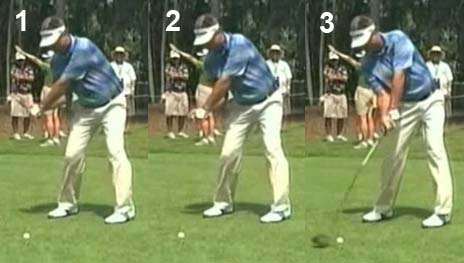
Ken Perry's downswing action - capture images from a swing video
Ken Perry, a hitter, uses a hitter's typical punch motion of the right elbow in his downswing. Image 1 shows Ken Perry entering the mid-downswing phase of his downswing action. Note how he has kept his power package intact, while the right right shoulder has moved downplane, thus delivering his right shoulder (launching pad for the release of PA#1) to a downplane position that is closer to the ball. Note that the right elbow has reached a position alongside the right hip, and this position is called the punch elbow position. A hitter does not usually actively drive the right elbow to a position in front of the right hip - pitch elbow position - like a swinger. Note how PA#1 releases in the mid-late downswing (images 2 & 3) and note that the right arm has not completely straightened by impact. Note that Ken Perry has an open pelvis at impact (image 3) but his right heel is still planted on the ground - and that fact is merely a reflection of the significant degree of flexibility that he has in his right hip joint and right lower limb, and there is no biomechanical advantage to keeping the right heel flat on the ground at impact. Many hitters have already rolled their right ankle over by impact, and their right heel may also be slightly raised off the ground if they have a significantly open pelvis at impact.Consider Lee Trevino's swing - http://www.youtube.com/watch?v=cDpnbkHm8Oo
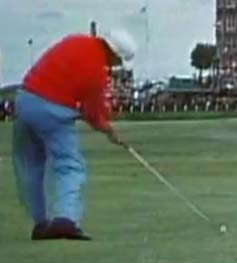
Lee Trevino (hitter) at impact- capture image from his swing video
Note that Lee Trevino's pelvis is significantly open at impact, and note that his right heel is slightly raised off the ground.A TGM hitter will usually maintain his "frozen" right wrist bend ("fixed" degree of dorsiflexion that he adopted at address) unchanged throughout the entire downswing and early followthrough.
At impact, the right forearm should be on-plane behind the clubshaft.
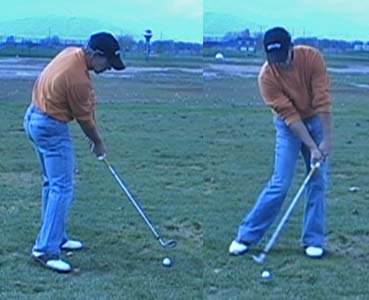
Scott (TGM hitter) posing at impact - capture image from his swing video
Note that Scott (a hitter) has his right forearm on-plane behind the clubshaft at impact. Note that he has maintained his "fixed" degree of right bend (dorsiflexion) throughout the downswing, which ensures that he has a flat left wrist and forward shaft lean at impact.Right arm swinging:
A right arm swinger can start the downswing with an active pivot action (like a left arm swinger) or he can use a reactive pivot action.
A reactive pivot action is a pivot action where the pelvis (lower body) reacts to movements happening above waist level. A right arm swinger can choose to start the downswing with an active upper body/right arm movement - active downplane thrust motion of the right shoulder and active adduction motion of the right upper arm towards the right side of the torso (so that the right elbow is driven towards a pitch position in front of the right hip) - and he will then allow the pelvis (lower body) to react to the active downplane thrust motion of the right shoulder/right upper arm. This reactive pelvis phenomenon works particularly well for a golfer who has zero/little hula hula flexibility, because he has a stiff spine that allows the right shoulder's downplane thrust action force to be transmitted down the rigid vertbral column in such a manner, that it shifts the lowest lumbar vertebra, and therefore the pelvis sacrum, left-laterally by 1-3". That small degree of left-lateral pelvic shift movement (hip bump motion) is just sufficient to allow the golfer to re-weight the left leg, and increasingly brace/straighten the left leg. If the lowest lumbar vertbrae move 1-3" left-laterally, then the degree of rightwards spinal tilt is being increased if the head is kept stationary - a phenomenon called secondary axis tilt - and secondary axis tilt makes it easier for the right shoulder to continue to move downplane (rather than roundhouse) during the remainder of the downswing. This reactive pivot action may not work well for a golfer who has a large degree of hula hula flexibility, because the right shoulder's downplane thrust action may not be transmitted down the spine to the lower body, and the pelvis may remain static during this active upper body action. If the pelvis remains static, then the golfer may end up performing an "upper body dive" motion where the right shoulder moves too horizontally and that roundhousing right shoulder movement will likely drive the hands/clubshaft OTT. A golfer, who has a large degree of hula hula flexibility, may be much better suited for a left arm swinger's active pivot action, which is the standard/traditional swing action used by the majority of professional golfers.
Different "right arm swing" golf instructors will describe the reactive pivot action in different ways.
Consider this swing video presentation by Kris Moe, who teaches the Gary Edwin right arm swing methodology - http://www.viddler.com/explore/krismoe/videos/7/
Note how he talks about the "feeling" of the arms swinging across the front of the body while the lower body remains quiet, and how he "feels" that the lower body's pivot action responds to the swinging arms.
Tom Tomasello describes his reactive pivot action differently - see chapter two of reference number [9].
Tom Tomasello states that a golfer should "feel" that he is swinging his clubshaft past his left thigh without there being any prior active movement of the pelvis left-laterally towards the target.
I think of the reactive pivot action differently. I previously stated that a golfer can acquire rightwards spinal tilt at address by shifting the pelvis to the left, thereby straightening the left side of the torso slightly, and this address-postural motion should give a golfer a "feeling" that the left leg is already pre-braced at address. That "feeling" of the left leg being braced is enhanced when the right shoulder's downplane thrust action (that initiates the downswing) transmits a "force" down the spine that pushes the pelvis left-laterally by 1-3" against a pre-braced left leg. If the left leg is increasingly braced as it becomes increasingly weighted during the early downswing, then it will resist any left-laterally directed force, and that "force" will be deflected and it will cause the left buttocks to automatically/naturally/secondarily move backwards in the direction of the tush line, and also slightly rightwards away from the target (left hip clearing action). In other words, I believe that the "left hip clearing action" will happen automatically/naturally/secondarily without any need for an active muscular contraction of the hip girdle muscles (as occurs in Tiger Woods swing, when he initiates the downswing with an active pelvic motion). You can see my "left hip clearing action" happening automatically/passively when I demonstrate the right arm swinger's swing action in my swing video lesson - I am making no deliberate/active effort to perform a "left hip clearing action", and I have exactly the "same feeling" of experiencing an efficient reactive pivot action when I perform a "stone skipping" action.
Each individual right arm swinger should experiment with an active pivot action, and a reactive pivot action, in order to determine which pivot action works best for him.
Presuming that a right arm swinger chooses to use a reactive pivot action, then the first downswing move is a simultaneous i) active downplane movement of the right shoulder and ii) an active adduction movement of the right upper arm towards the right side of the torso so that the right elbow moves to a pitch position in front of the right hip. These two simultaneous movements allows a right arm swinger to keep the power package intact, and also maintain the right elbow bend unchanged while the right elbow moves to its pitch position in front of the right hip. The inert left arm is being passively driven forward by push-pressure from the right palm at PP#1. At this time-point, the golfer should look like Ben Hogan in image 5 in this next composite photo.

Ben Hogan's early-mid downswing - capture images from his swing video
When a right arm swinger reaches the delivery position (mimicing Ben Hogan's positional alignments in image 5), the right arm should already be adducted alongside the right side of the torso, the right elbow should be nearly reaching its pitch location in front of the right hip, the left arm should be moving down-and-out towards impact secondary to active push-pressure at PP#1, and the right elbow should still be bent at roughly a 90 degree angle. The pelvis should have shifted a few inches to the left and the left buttocks should be moving back towards the tush line so that the pelvis becomes slightly open (relative to the ball-target line) - due to the biomechanical phenomena happening during the reactive pivot action (as previously explained).When the right elbow reaches its pitch location, it is leading the hands. From this time-point onwards, the right elbow will actively straighten and the right forearm will paddlewheel towards impact. The fulcrum point for the right forearm paddlewheeling action is the right elbow, which remains at its pitch location in front of the right hip during the remainder of the downswing. The right arm straightening action (due to active contraction of the right triceps muscle) should occur with enough isotonic force, so that it allows the right palm to maintain extensor action via push-pressure at PP#1 while also ensuring that the right hand keeps up with the previously pushed left hand during the release swivel phase of the downswing (from the 3rd parallel to impact). However, the isotonic force cannot be excessive because an excessive right arm straightening force may interfere with the passive/centrifugal release of PA#2 and PA#3. The "feeling" of the right arm straightening action should "feel" identical to the "feeling" of the right arm straightening action that happens when skipping stones. A stone skipper will initiate a right arm throw action at the start of the right arm throw action that will drive the right elbow to its pitch location in the first phase of the throw action. Then, a stone skipper will "feel" his right elbow straightening as the right forearm is thrown forward toward the target. The "feeling" should be that the right forearm is being thrown by the initiating active right upper arm adduction throw action (combined with the active downplane thrust-motion of the right shoulder) - and it should "feel" like the right forearm is being "whipped" towards impact. The "feeling" of the right forearm being thrown in the late downswing should "feel" distinctly different to the "feeling" that a TGM-hitter will experience when actively/forcefully straightening the right elbow in a straight line thrust action towards the ball, because in that hitter's scenario the right forearm motion will be much more forcefully directed down-and-out towards the ball in an active straight-line thrust manner, so that the right hand can drive-load the clubshaft all the way into impact.
A key point that a golfer needs to understand is that swing power is generated in a right arm swinger's swing by the right arm generating an active thrust force (push-force) in the early downswing - between image 1 and image 3 in the Hogan photos, and when the left arm passes the 9 o'clock position (which marks the end of the early downswing and the beginning of the mid-downswing) the active thrust action should already be rapidly diminishing, and PA#4 should start releasing. In other words, the active thrust action of the right arm throw action happens while the right elbow is still bent at roughly a ninety degree angle. This biomechanical feature distinguishes right arm swinging from hitting (where right arm swing power is mainly generated in the mid-downswing due to the active straightening of the right elbow).
A right arm swinger should "feel" the left arm swiveling into impact due to the passive release of PA#3 - like a left arm swinger. However, compared to a left arm swinger, the left arm may be traveling slower because it is being pushed by the right arm (rather than being catapulted forward at a fast speed by an active pivot-drive action - as occurs in a left arm swinger's downswing action). Therefore, a right arm swinger may "feel" that the right palm is actively assisting the left hand's PA#3 release roll-over action - as the right forearm paddlewheels into impact during the late downswing. In a left arm swinger's release swivel action, the supinating left forearm will rotate the left hand into impact automatically/naturally, and a left arm swinger does not usually require any assistance from the paddlewheeling right forearm/hand to ensure an efficient release of PA#3.
At impact, the right forearm should be on-plane behind the clubshaft and the right wrist should still be bent (as occurs in a left arm swinger's action).
The low point of the clubhead arc will be opposite the left shoulder in a right arm swinger (as well as in a hitter or left arm swinger) because the maximum swing radius is determined by the straight left arm and the clubshaft that is straight-in-line with the left arm, and it is not dependent on the biomechanical mechanisms responsible for powering the swing.
Followthrough-to-finish:
Hitting:A TGM-hitter will usually use angled hinging, and not horizontal hinging, during the followthrough phase of the swing.

Ken Perry's followthrough - capture images from his swing video
During the late downswing (from the 3rd parallel to impact), a TGM hitter is not using a release swivel action, and he is drive-loading the clubshaft continuously through the impact zone. During the late phase of the downswing, as the right forearm is driving into impact, the right palm is moving relatively square to the clubhead arc (image 1). The right palm continues to drive forward in the same way post-impact (image 2 &3) and it causes the back of the flat left wrist/hand to move perpendicular to the inclined plane during the followthrough (note that the back of Ken Perry's flat left wrist/hand and clubface is roughly at a 45 degree angle to the ground, and therefore perpendicular to the inclined plane, in image 3).After the followthrough phase is completed, a TGM hitter will often use a hold-off finish action, rather than a finish swivel action. However, the finish action style is usually dependent on the individual golfer and his selected shot shape.
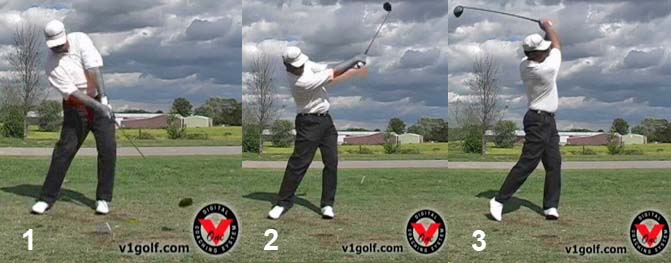
Ken Perry's finsh action - capture images from a swing video.
Image 1 shows Ken Perry at the end of the followthrough - note that his clubface and flat left wrist/hand is perpendicular to the inclined plane because he is using an angled hinging action during the followthrough.Image 2 shows Ken Perry performing a finish swivel action where the right hand is pronating over a supinating left hand. Image 3 shows Ken Perry completing the finish phase of his swing.
It is not surprising that Ken Perry prefers to use a finish swivel action during the finish phase of his swing, because he prefers to draw the ball.
By contrast, Lee Trevino, another hitter, preferred to deliberately fade the ball when he played on the PGA tour and he therefore preferred to use a hold-off finish action during the finish phase of his swing.
Here is an U-tube video where Lee Trevino discusses his preference for not "releasing" the club into a finish swivel action - http://www.youtube.com/watch?v=ZVXnamjubYo
In that video, you will note that Lee Trevino does not use a finish swivel action - he does not actively pronate the right hand over a supinating left hand in the early finish phase of his swing.
Right arm swinging:
A right arm swinger should preferably use a horizontal hinging action during the followthrough phase of his swing - like a left arm swinger.
Consider the followthrough phase of Tiger Woods' swing.

Tiger Woods followthrough - capture images from a swing video.
Note that Tiger Woods, a left arm swinger, uses a horizontal hinging action during the followthrough phase of his driver swing - note that the back of his flat left wrist/hand and clubface is perpendicular to the ground at the end of his followthrough (image 4). His right arm is fully straight and it appears that he is "trying to shake hands with the target" with his right hand, which is outstretched and parallel to the ball-target line.A right arm swinger should attempt to get to that same "shaking hands with the target" position by the end of his followthrough. To achieve that goal, a right arm swinger must continue to actively rotate the right shoulder under the chin and he must allow the right arm to actively straighten while ensuring that the radial border of the right forearm and right thumb face skywards by the end of the followthrough. The motion of ensuring that the radial border of the right forearm faces skywards by the end of the followthrough (when the clubshaft reaches the 4th parallel position) is not a right forearm pronatory motion. The right forearm is not pronating and it is in its neutral position (neither pronated or supinated). To get to that position (image 4) without any right forearm pronation, a right arm swinger needs to actively continue to pivot-rotate his torso during the followthrough phase of his swing. I cannot over-emphasize this point - the need of a right arm swinger to continue to actively pivot-rotate the torso during the followthrough/finish phase of his swing, so that he can get his right arm/hand into a "shaking hands with the target" position where the right forearm is in a neutral (non-pronated) position. If a right arm swinger actively swings through this "shaking hands with the target" position, then the followthrough phase should effortlessly evolve into a finish swivel action and subsequently a completed finish where the golfer is standing erect in perfect balance over his straight left leg.
Conclusion:
The primary purpose of this review paper is to educate golfers about the fact that there are alternative biomechanical methods of powering, and executing, a full golf swing; and secondarily that the different methodologies use different swing biomechanics/mechanics. I am not a swing ideologue, who is trying to promote a particular method of swinging a golf club as being the "perfect" method. I am more interested in obtaining a complete understanding of golf swing biomechanics/mechanics, so that I can share my insights with my website visitors. I strongly believe that it is possible to swing a golf club perfectly as a left arm swinger, as a right arm swinger and as a hitter - as long as the adopted biomechanical/mechanical approach is logically coherent from a biomechanical/mechanical efficacy perspective. I think that each individual golfer should make an independent decision as to which swing methodology is best suited for him, and I believe that he should learn how to execute that swing methodology using sound biomechanics/mechanics. If this review paper helps each individual golfer achieve that goal, then I will feel that my personal effort - thinking about, and experimenting with, alternative swing biomechanical/mechanical approaches - has been worthwhile.
Jeffrey Mann.
First version: September 2009.
References:
1. The Plane Truth for Golfers. Jim Hardy.
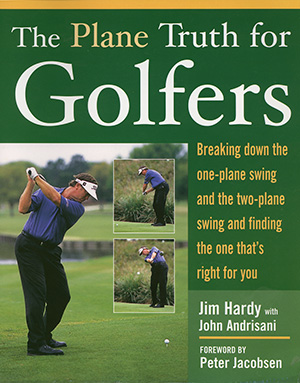
The Plane Truth for Golfers Master Class. Jim Hardy.
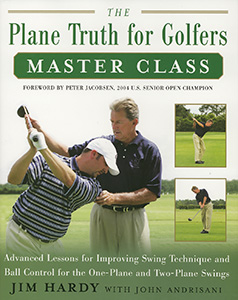
2. Hank Haney's Essentials of the Swing. Hank Haney.
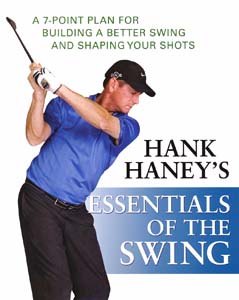
3. Ben Hogan's Five Lessons. Ben Hogan.
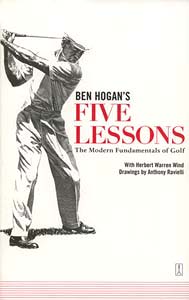
4. Perfect Pivot - Part 1: Backswing Pivot. Brian Manzella.
http://www.brianmanzella.com/forum/showthread.php?t=3675&highlight=article
5. Slice video. Oliver Heuler.
http://golfforum.de/startseite/slice
The text on that website page is in German, but the video is in English.
6. The Fundamentals of Hogan. David Leadbetter.
7. Golf Swing Secrets ... and Lies. Six Timeless Lessons. Michael Hebron.
8. The Golfing Machine. Homer Kelley.
9. Tom Tomasello videos freely obtainable from Lynn Blake's golf website.
Tim & Lee Deitrick Chapter 1 - Swing DiscussionTim & Lee Deitrick Chapter 2 - Swing Demonstration
10. Peter Croker's Path to Better Golf. Peter Croker.



